This page includes information about the medicinal use of wetlands plants by Native American groups. One important issue of note is the difference in purpose or effect for some Native American uses of plants. As Moerman notes in his work "Native American Medicinal Plants" some plants were used by Native Americans to treat things like kidney issues by inducing urination. A plant may well result in increased urination in which case the plant would be considered efficacious by Native standards. By Western standards the plant may not be seen as efficacious if there is no change in the kidney condition but the plant did do what was expected.
Additionally, this website is for entertainment purposes only. Please consult a licensed medical professional before using any of these plants to treat any illness.
Additionally, this website is for entertainment purposes only. Please consult a licensed medical professional before using any of these plants to treat any illness.
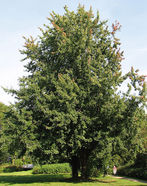
Acer saccharinum
Silver Maple
Wetland Indicator: FACW
Physiographic Provinces: Appalachian Plateau, Valley and Ridge, Blue Ridge, Piedmont, Coastal Plain
Native American usage:
Infusion of bark taken for cramps, dysentery, hives, measles, cough gonorrhea
Inner bark boiled and used with water as eye wash and also for running sores and for diarrhea
Compound infusion of bark taken for “female trouble” and as a diuretic
Photo credit: unnamed author @ commons.wikimedia.org
Silver Maple
Wetland Indicator: FACW
Physiographic Provinces: Appalachian Plateau, Valley and Ridge, Blue Ridge, Piedmont, Coastal Plain
Native American usage:
Infusion of bark taken for cramps, dysentery, hives, measles, cough gonorrhea
Inner bark boiled and used with water as eye wash and also for running sores and for diarrhea
Compound infusion of bark taken for “female trouble” and as a diuretic
Photo credit: unnamed author @ commons.wikimedia.org
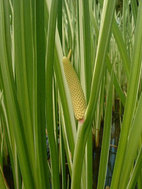
Acorus calamus
Sweet Flag
Wetland Indicator: OBL
Physiographic Provinces: Appalachian Plateau, Valley and Ridge, Blue Ridge, Piedmont, Coastal Plain
Native American usage:
Decoction of roots taken for stomach gas
Infusion of ground roots taken for colds, sometimes mixed with chokecherry
Infusion of roots taken after childbirth and for symptoms of menopause
Infusion of ground roots and pepperroot taken for heart disease
Poultice of roots applied for cramps and applied to toothaches
Root chewed and juice swallowed for diarrhea
Used as a diuretic
Infusion of roots used for bowel problems and as a laxative
Infusion of plants used for bronchial trouble, earache
Decoction of rootstock used for whooping cough, sore throat, lower back pain, venereal disease
Root compound taken for suppressed menses
Compound infusion of roots taken for tapeworms
Infusion of root taken for high blood pressure and diabetes
Root used for cholera, smallpox and other epidemics
Photo credit: JF Gaffard @ commons.wikimedia.org
Sweet Flag
Wetland Indicator: OBL
Physiographic Provinces: Appalachian Plateau, Valley and Ridge, Blue Ridge, Piedmont, Coastal Plain
Native American usage:
Decoction of roots taken for stomach gas
Infusion of ground roots taken for colds, sometimes mixed with chokecherry
Infusion of roots taken after childbirth and for symptoms of menopause
Infusion of ground roots and pepperroot taken for heart disease
Poultice of roots applied for cramps and applied to toothaches
Root chewed and juice swallowed for diarrhea
Used as a diuretic
Infusion of roots used for bowel problems and as a laxative
Infusion of plants used for bronchial trouble, earache
Decoction of rootstock used for whooping cough, sore throat, lower back pain, venereal disease
Root compound taken for suppressed menses
Compound infusion of roots taken for tapeworms
Infusion of root taken for high blood pressure and diabetes
Root used for cholera, smallpox and other epidemics
Photo credit: JF Gaffard @ commons.wikimedia.org
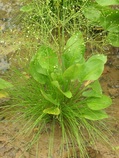
Alisma subcordatum
American Water Plantain
Wetland Indicator: OBL
Physiographic Provinces: Appalachian Plateau, Valley and Ridge, Blue Ridge, Piedmont, Coastal Plain
Native American usage:
Used as a poultice on old sores, wounds, bruises, swellings and ulcers
Root used for bowel complaints
Photo credit: William S. Justice @ USDA-NRCS PLANTS Database
American Water Plantain
Wetland Indicator: OBL
Physiographic Provinces: Appalachian Plateau, Valley and Ridge, Blue Ridge, Piedmont, Coastal Plain
Native American usage:
Used as a poultice on old sores, wounds, bruises, swellings and ulcers
Root used for bowel complaints
Photo credit: William S. Justice @ USDA-NRCS PLANTS Database
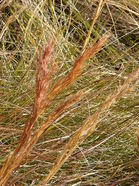
Andropogon glomeratus
Bushy Bluestem
Wetland Indicator: FACW+
Physiographic Provinces: Valley and Ridge, Blue Ridge, Piedmont, Coastal Plain
Native American usage:
Roots used for backaches
Infusion of roots applied to poison ivy rash to calm itch
Compound poultice with roots applied as salve to hemorrhoids
Photo credit: Forest & Kim Starr @ commons.wikimedia.org
Bushy Bluestem
Wetland Indicator: FACW+
Physiographic Provinces: Valley and Ridge, Blue Ridge, Piedmont, Coastal Plain
Native American usage:
Roots used for backaches
Infusion of roots applied to poison ivy rash to calm itch
Compound poultice with roots applied as salve to hemorrhoids
Photo credit: Forest & Kim Starr @ commons.wikimedia.org
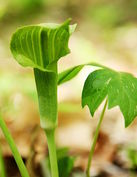
Arisaema triphyllum
Jack in the Pulpit
Wetland Indicator: FACW-
Physiographic Provinces: Appalachian Plateau, Valley and Ridge, Blue Ridge, Piedmont, Coastal Plain
Native American usage:
Poultice of root used for headaches and skin diseases
Used to relieve gas
Taken for colds and dry coughs
Poultice of boiled and beaten roots and mixed with meal and applied to sores
Used as a liniment and a stimulant
Infusion used for throat irritations
Decoction of root used for eye wash
Decoction of plant given to children for diarrhea
Hot poultice of plant applied to bruises and for lameness
Compound used for insomnia
Root used for rattlesnake bite
Photo credit: Daniel Schwen @ commons.wikimedia.org
Jack in the Pulpit
Wetland Indicator: FACW-
Physiographic Provinces: Appalachian Plateau, Valley and Ridge, Blue Ridge, Piedmont, Coastal Plain
Native American usage:
Poultice of root used for headaches and skin diseases
Used to relieve gas
Taken for colds and dry coughs
Poultice of boiled and beaten roots and mixed with meal and applied to sores
Used as a liniment and a stimulant
Infusion used for throat irritations
Decoction of root used for eye wash
Decoction of plant given to children for diarrhea
Hot poultice of plant applied to bruises and for lameness
Compound used for insomnia
Root used for rattlesnake bite
Photo credit: Daniel Schwen @ commons.wikimedia.org
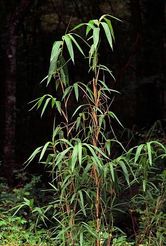
Arundinaria gigantea
Giant Cane
Wetland Indicator: FACW
Physiographic Provinces: Appalachian Plateau, Valley and Ridge, Blue Ridge, Piedmont, Coastal Plain
Native American usage:
Decoction of roots taken for breast pain, also to stimulate kidneys and “renew strength”
Photo credit: Ted Bodner, James H Miller @ commons.wikimedia.org
Giant Cane
Wetland Indicator: FACW
Physiographic Provinces: Appalachian Plateau, Valley and Ridge, Blue Ridge, Piedmont, Coastal Plain
Native American usage:
Decoction of roots taken for breast pain, also to stimulate kidneys and “renew strength”
Photo credit: Ted Bodner, James H Miller @ commons.wikimedia.org
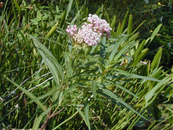
Asclepias incarnata
Swamp Milkweed
Wetland Indicator: OBL
Physiographic Provinces: Appalachian Plateau, Valley and Ridge, Blue Ridge, Piedmont, Coastal Plain
Native American usage:
Infusion of roots used as a strengthening bath for children and adults
Cold infusion of roots used to heal a baby’s navel
Decoction of plant taken for the kidneys, some groups used it for too much urine production and
some for too little urine production
Root used to induce vomiting and as a diuretic
Photo credit: Nelson DeBarros @ USDA-NRCS PLANTS Database
Swamp Milkweed
Wetland Indicator: OBL
Physiographic Provinces: Appalachian Plateau, Valley and Ridge, Blue Ridge, Piedmont, Coastal Plain
Native American usage:
Infusion of roots used as a strengthening bath for children and adults
Cold infusion of roots used to heal a baby’s navel
Decoction of plant taken for the kidneys, some groups used it for too much urine production and
some for too little urine production
Root used to induce vomiting and as a diuretic
Photo credit: Nelson DeBarros @ USDA-NRCS PLANTS Database
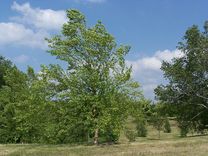
Betula nigra
River Birch
Wetland Indicator: FACW
Physiographic Provinces: Appalachian Plateau, Valley and Ridge, Blue Ridge, Piedmont, Coastal Plain
Native American usage:
Leaves chewed or infusion taken for dysentery
Infusion taken for colds
Infusion or decoction of bark taken for the stomach
Infusion or decoction of bark taken for difficult urination, “milky urine”
Photo credit: SEWIlco @ commons.wikimedia.org
River Birch
Wetland Indicator: FACW
Physiographic Provinces: Appalachian Plateau, Valley and Ridge, Blue Ridge, Piedmont, Coastal Plain
Native American usage:
Leaves chewed or infusion taken for dysentery
Infusion taken for colds
Infusion or decoction of bark taken for the stomach
Infusion or decoction of bark taken for difficult urination, “milky urine”
Photo credit: SEWIlco @ commons.wikimedia.org
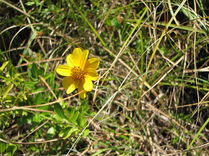
Bidens coronata
Large Fruit Beggarticks
Wetland Indicator: OBL
Physiographic Provinces: Piedmont, Coastal Plain
Native American usage:
Infusion of roots taken for sun sickness: eye disease, headache, high fever and diarrhea
Infusion of roots for fire sickness: fever and body aches
Infusion of whole plant taken and used as a bath for mist sickness: eye disease, fever and chills
Photo credit: Choess @ commons.wikimedia.org
Large Fruit Beggarticks
Wetland Indicator: OBL
Physiographic Provinces: Piedmont, Coastal Plain
Native American usage:
Infusion of roots taken for sun sickness: eye disease, headache, high fever and diarrhea
Infusion of roots for fire sickness: fever and body aches
Infusion of whole plant taken and used as a bath for mist sickness: eye disease, fever and chills
Photo credit: Choess @ commons.wikimedia.org
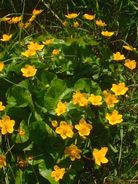
Caltha palustris
Yellow Marsh Marigold
Wetland Indicator: OBL
Physiographic Provinces: Valley and Ridge, Blue Ridge, Piedmont, Coastal Plain
Native American usage:
Plant and/or raw leaves considered poisonous by some groups
Decoction of roots taken for colds, specifically to cause sweating, expel mucous and cause vomiting
Poultice of boiled and mashed roots applied to sores
Compound decoction of leaves and stalks taken as a diuretic
Compound decoction of root taken during pregnancy
Infusion of leaves taken for constipation
Photo credit: Jeffdelonge @ commons.wikimedia.org
Yellow Marsh Marigold
Wetland Indicator: OBL
Physiographic Provinces: Valley and Ridge, Blue Ridge, Piedmont, Coastal Plain
Native American usage:
Plant and/or raw leaves considered poisonous by some groups
Decoction of roots taken for colds, specifically to cause sweating, expel mucous and cause vomiting
Poultice of boiled and mashed roots applied to sores
Compound decoction of leaves and stalks taken as a diuretic
Compound decoction of root taken during pregnancy
Infusion of leaves taken for constipation
Photo credit: Jeffdelonge @ commons.wikimedia.org
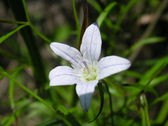
Campanula aparinoides
Marsh Bellflower
Wetland Indicator: OBL
Physiographic Provinces: Valley and Ridge, Blue Ridge, Piedmont, Coastal Plain
Native American usage:
Decoction of stems taken by young women to induce childbirth
Photo credit: Superior National Forest @ commons.wikimedia.org
Marsh Bellflower
Wetland Indicator: OBL
Physiographic Provinces: Valley and Ridge, Blue Ridge, Piedmont, Coastal Plain
Native American usage:
Decoction of stems taken by young women to induce childbirth
Photo credit: Superior National Forest @ commons.wikimedia.org
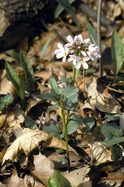
Cardamine douglassii
Purple Bittercress
Wetland Indicator: FACW+
Physiographic Provinces: Piedmont, Coastal Plain
Native American usage:
Infusion of smashed roots to counteract any kind of poison
Photo credit: public domain
Purple Bittercress
Wetland Indicator: FACW+
Physiographic Provinces: Piedmont, Coastal Plain
Native American usage:
Infusion of smashed roots to counteract any kind of poison
Photo credit: public domain
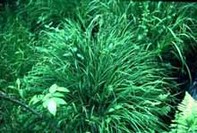
Carex prasina
Drooping sedge
Wetland Indicator: OBL
Physiographic Provinces: Appalachian Plateau, Valley and Ridge, Blue Ridge, Piedmont, Coastal Plain
Native American usage:
Decoction taken to induce vomiting or “when stomach is bad from an unknown cause”
Photo credit: Eric Epstein, WDNR @ dnr.wi.gov
Drooping sedge
Wetland Indicator: OBL
Physiographic Provinces: Appalachian Plateau, Valley and Ridge, Blue Ridge, Piedmont, Coastal Plain
Native American usage:
Decoction taken to induce vomiting or “when stomach is bad from an unknown cause”
Photo credit: Eric Epstein, WDNR @ dnr.wi.gov
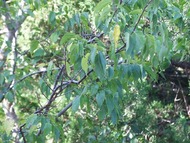
Celtis laevigata
Sugarberry
Wetland Indicator: FACW
Physiographic Provinces: Valley and Ridge, Blue Ridge, Piedmont, Coastal Plain
Native American usage:
Decoction of bark taken for sore throat
Compound decoction of bark with powdered shells taken for venereal disease
Photo credit: public domain
Sugarberry
Wetland Indicator: FACW
Physiographic Provinces: Valley and Ridge, Blue Ridge, Piedmont, Coastal Plain
Native American usage:
Decoction of bark taken for sore throat
Compound decoction of bark with powdered shells taken for venereal disease
Photo credit: public domain
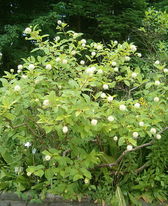
Cephalanthus occidentalis
Button Bush
Wetland Indicator: OBL
Physiographic Provinces: Appalachian Plateau, Valley and Ridge, Blue Ridge, Piedmont, Coastal Plain
Native American usage:
Poultice of warmed roots applied to head for eye troubles, decoction of bark used as a wash for sore eyes
Decoction of bark used for dysentery
Root and bark used for fever
Bark chewed for toothache
Decoction of roots for hemorrhages, rheumatism, enlarged muscles
Inner bark used to induce vomiting
Decoction of bark taken for headache
Photo credit: User:BotBln @ commons.wikimedia.org
Button Bush
Wetland Indicator: OBL
Physiographic Provinces: Appalachian Plateau, Valley and Ridge, Blue Ridge, Piedmont, Coastal Plain
Native American usage:
Poultice of warmed roots applied to head for eye troubles, decoction of bark used as a wash for sore eyes
Decoction of bark used for dysentery
Root and bark used for fever
Bark chewed for toothache
Decoction of roots for hemorrhages, rheumatism, enlarged muscles
Inner bark used to induce vomiting
Decoction of bark taken for headache
Photo credit: User:BotBln @ commons.wikimedia.org
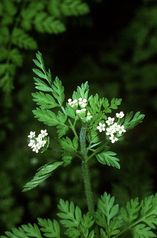
Chaerophyllum procumbens
Spreading Chervil
Wetland Indicator: FACW
Physiographic Provinces: Valley and Ridge, Blue Ridge, Piedmont, Coastal Plain
Native American usage:
Poisonous root used to induce vomiting
Photo credit: public domain
Spreading Chervil
Wetland Indicator: FACW
Physiographic Provinces: Valley and Ridge, Blue Ridge, Piedmont, Coastal Plain
Native American usage:
Poisonous root used to induce vomiting
Photo credit: public domain
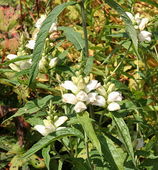
Chelone glabra
White Turtlehead
Wetland Indicator: OBL
Physiographic Provinces: Appalachian Plateau, Valley and Ridge, Blue Ridge, Piedmont, Coastal Plain
Native American usage:
Infusion of roots and cedar bark used as a medicinal tea
Infusion of blooms taken for worms, fevers, as a laxative
Used for sores or skin eruptions, taken to increase appetite
Compound decoction of roots taken for too much bile
Infusion of plants used to prevent pregnancy
Photo credit: Michael Wolf @ commons.wikimedia.org
White Turtlehead
Wetland Indicator: OBL
Physiographic Provinces: Appalachian Plateau, Valley and Ridge, Blue Ridge, Piedmont, Coastal Plain
Native American usage:
Infusion of roots and cedar bark used as a medicinal tea
Infusion of blooms taken for worms, fevers, as a laxative
Used for sores or skin eruptions, taken to increase appetite
Compound decoction of roots taken for too much bile
Infusion of plants used to prevent pregnancy
Photo credit: Michael Wolf @ commons.wikimedia.org
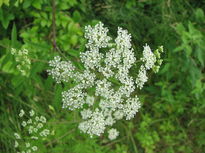
Cicuta maculata
Water Hemlock
Wetland Indicator: OBL
Physiographic Provinces: Appalachian Plateau, Valley and Ridge, Blue Ridge, Piedmont, Coastal Plain
Native American usage:
Roots considered poisonous by some groups, was chewed to commit suicide by some groups
Roots chewed and swallowed for four days by women as contraception and to induce permanent sterility
Dried root powdered and made into a liniment to apply externally
Poultice of smashed roots applied for lameness, running sores or cuts
Decoction of plants used on bruises, sprains, sore joints or broke bones
Photo credit: Choess @ commons.wikimedia.org
Water Hemlock
Wetland Indicator: OBL
Physiographic Provinces: Appalachian Plateau, Valley and Ridge, Blue Ridge, Piedmont, Coastal Plain
Native American usage:
Roots considered poisonous by some groups, was chewed to commit suicide by some groups
Roots chewed and swallowed for four days by women as contraception and to induce permanent sterility
Dried root powdered and made into a liniment to apply externally
Poultice of smashed roots applied for lameness, running sores or cuts
Decoction of plants used on bruises, sprains, sore joints or broke bones
Photo credit: Choess @ commons.wikimedia.org
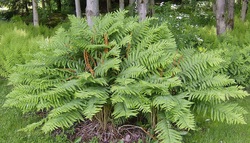
Cinna arundinacea
Wood Reedgrass
Wetland Indicator: FACW+
Physiographic Provinces: Appalachian Plateau, Valley and Ridge, Blue Ridge, Piedmont, Coastal Plain
Native American usage:
Compound decoction taken for diabetes
Photo credit: public domain
Wood Reedgrass
Wetland Indicator: FACW+
Physiographic Provinces: Appalachian Plateau, Valley and Ridge, Blue Ridge, Piedmont, Coastal Plain
Native American usage:
Compound decoction taken for diabetes
Photo credit: public domain
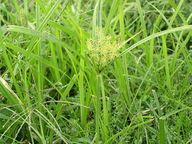
Cyperus esculentus
Chufa
Wetland Indicator: FACW
Physiographic Provinces: Appalachian Plateau, Valley and Ridge, Blue Ridge, Piedmont, Coastal Plain
Native American usage:
Roots chewed for colds and coughs
Poultice of roots applied to snakebites
Photo credit: User: Blahedo @ commons.wikimedia.org
Chufa
Wetland Indicator: FACW
Physiographic Provinces: Appalachian Plateau, Valley and Ridge, Blue Ridge, Piedmont, Coastal Plain
Native American usage:
Roots chewed for colds and coughs
Poultice of roots applied to snakebites
Photo credit: User: Blahedo @ commons.wikimedia.org
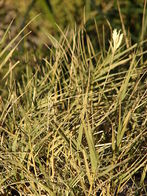
Distichlis spicata
Seashore Saltgrass
Wetland Indicator: FACW+
Physiographic Provinces: Coastal Plain
Native American usage:
Infusion of plant taken “when the heart beats fast”, also as a laxative
Cold infusion of plant taken for gonorrhea
Decoction of salt cooked into a gum, held in the mouth and allowed to melt for bad cold or for loss of appetite
Photo credit: Forest & Kim Starr @ commons.wikimedia.org
Seashore Saltgrass
Wetland Indicator: FACW+
Physiographic Provinces: Coastal Plain
Native American usage:
Infusion of plant taken “when the heart beats fast”, also as a laxative
Cold infusion of plant taken for gonorrhea
Decoction of salt cooked into a gum, held in the mouth and allowed to melt for bad cold or for loss of appetite
Photo credit: Forest & Kim Starr @ commons.wikimedia.org
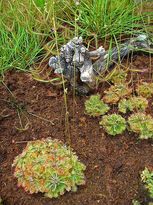
Drosera capillaris
Pink Sundew
Wetland Indicator: OBL
Physiographic Provinces: Piedmont, Coastal Plain
Native American usage:
Sticky, plant glands rubbed on ringworm sores
Photo credit: H Zell @ commons.wikimedia.org
Pink Sundew
Wetland Indicator: OBL
Physiographic Provinces: Piedmont, Coastal Plain
Native American usage:
Sticky, plant glands rubbed on ringworm sores
Photo credit: H Zell @ commons.wikimedia.org
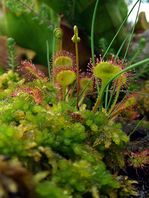
Drosera rotundifolia
Roundleaf Sundew
Wetland Indicator: OBL
Physiographic Provinces: Valley and Ridge, Blue Ridge, Piedmont, Coastal Plain
Native American usage:
Plant used for corns, warts and bunions
Photo credit: GFDL @ commons.wikimedia.org
Roundleaf Sundew
Wetland Indicator: OBL
Physiographic Provinces: Valley and Ridge, Blue Ridge, Piedmont, Coastal Plain
Native American usage:
Plant used for corns, warts and bunions
Photo credit: GFDL @ commons.wikimedia.org
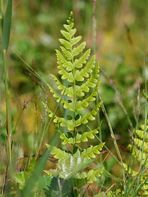
Dryopteris cristata
Crested Woodfern
Wetland Indicator: FACW+
Physiographic Provinces: Valley and Ridge, Blue Ridge, Piedmont, Coastal Plain
Native American usage:
Infusion of root used for stomach trouble
Photo credit: Kristian Peters @ commons.wikimedia.org
Crested Woodfern
Wetland Indicator: FACW+
Physiographic Provinces: Valley and Ridge, Blue Ridge, Piedmont, Coastal Plain
Native American usage:
Infusion of root used for stomach trouble
Photo credit: Kristian Peters @ commons.wikimedia.org
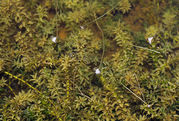
Elodea canadensis
Broad water weed
Wetland Indicator: OBL
Physiographic Provinces: Valley and Ridge, Blue Ridge, Piedmont, Coastal Plain
Native American usage:
Infusion of plant taken to induce vomiting
Photo credit: Christian Fischer @ commons.wikimedia.org
Broad water weed
Wetland Indicator: OBL
Physiographic Provinces: Valley and Ridge, Blue Ridge, Piedmont, Coastal Plain
Native American usage:
Infusion of plant taken to induce vomiting
Photo credit: Christian Fischer @ commons.wikimedia.org

Equisetum hymale var. affine
Scouring Rush Horsetail
Wetland Indicator: FACW
Physiographic Provinces: Appalachian Plateau, Valley and Ridge, Blue Ridge, Piedmont, Coastal Plain
Native American usage:
Decoction of plant taken for kidney problems and inability to urinate
Infusion of plant used as an eye wash
Decoction of plant taken for backache
Compound decoction of roots taken for gonorrhea
Photo credit: Joseph A. Marcus @ wildflower.org
Scouring Rush Horsetail
Wetland Indicator: FACW
Physiographic Provinces: Appalachian Plateau, Valley and Ridge, Blue Ridge, Piedmont, Coastal Plain
Native American usage:
Decoction of plant taken for kidney problems and inability to urinate
Infusion of plant used as an eye wash
Decoction of plant taken for backache
Compound decoction of roots taken for gonorrhea
Photo credit: Joseph A. Marcus @ wildflower.org
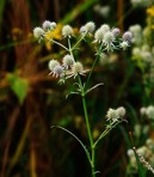
Eryngium aquaticum
Marsh Coyote Thistle
Wetland Indicator: OBL
Physiographic Provinces: Piedmont, Coastal Plain
Native American usage:
Infusion of plant taken to induce vomiting
Root used as an “anti-poison” good for snakebite
Roots used as a diuretic, expectorant and as a stimulant also for tapeworms and pinworms
Plant used to treat gonorrhea and roots used alone and in combination to treat venereal diseases
Photo credit: Kenneth Lawless @ vaplantatlas.org
Marsh Coyote Thistle
Wetland Indicator: OBL
Physiographic Provinces: Piedmont, Coastal Plain
Native American usage:
Infusion of plant taken to induce vomiting
Root used as an “anti-poison” good for snakebite
Roots used as a diuretic, expectorant and as a stimulant also for tapeworms and pinworms
Plant used to treat gonorrhea and roots used alone and in combination to treat venereal diseases
Photo credit: Kenneth Lawless @ vaplantatlas.org
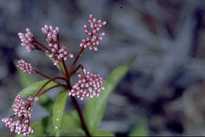
Eupatorium maculatum
Spotted Joe Pye Weed
Wetland Indicator: FACW
Physiographic Provinces: Valley and Ridge, Blue Ridge, Piedmont
Native American usage:
Taken for menstrual disorders and to facilitate recovery after childbirth
Infusion of plant taken to induce vomiting
Root used as an “anti-poison” good for snakebite and for rheumatism
Roots used as a diuretic, expectorant and as a stimulant also for tapeworms and pinworms
Plant used to treat gonorrhea and roots used alone and in combination to treat venereal diseases
Compound infusion of roots taken for liver sickness and for kidney trouble
Infusion of roots taken for colds, chills and fever
Photo credit: Robert H. Mohlenbrock @ USDA-NRCS PLANTS Database / USDA NRCS. 1995. Northeast wetland flora: Field office guide to plant species. Northeast National Technical Center, Chester
Spotted Joe Pye Weed
Wetland Indicator: FACW
Physiographic Provinces: Valley and Ridge, Blue Ridge, Piedmont
Native American usage:
Taken for menstrual disorders and to facilitate recovery after childbirth
Infusion of plant taken to induce vomiting
Root used as an “anti-poison” good for snakebite and for rheumatism
Roots used as a diuretic, expectorant and as a stimulant also for tapeworms and pinworms
Plant used to treat gonorrhea and roots used alone and in combination to treat venereal diseases
Compound infusion of roots taken for liver sickness and for kidney trouble
Infusion of roots taken for colds, chills and fever
Photo credit: Robert H. Mohlenbrock @ USDA-NRCS PLANTS Database / USDA NRCS. 1995. Northeast wetland flora: Field office guide to plant species. Northeast National Technical Center, Chester
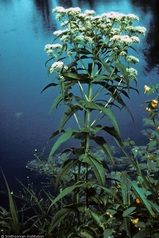
Eupatorium perfoliatum
Boneset
Wetland Indicator: FACW
Physiographic Provinces: Appalachian Plateau, Valley and Ridge, Blue Ridge, Piedmont, Coastal Plain
Native American usage:
Used to mend bones
Infusion taken for colds, sore throat, chills and fever, stomach medicine
Used as a tonic, to induce vomiting, as a diuretic
Root used to correct irregular menses
Poultice of chewed plants applied to rattlesnake bites
Poultice of smashed plants applied for headaches, for typhoid
Infusion of roots used as a wash and a poultice for syphilis sores
Plant used for hemorrhoids
Compound decoction of roots taken for the kidneys, pneumonia and pleurisy
Compound decoction of flowers and leaves taken as a laxative and to expel worms
Photo credit: R.A. Howard @ USDA-NRCS PLANTS Database
Boneset
Wetland Indicator: FACW
Physiographic Provinces: Appalachian Plateau, Valley and Ridge, Blue Ridge, Piedmont, Coastal Plain
Native American usage:
Used to mend bones
Infusion taken for colds, sore throat, chills and fever, stomach medicine
Used as a tonic, to induce vomiting, as a diuretic
Root used to correct irregular menses
Poultice of chewed plants applied to rattlesnake bites
Poultice of smashed plants applied for headaches, for typhoid
Infusion of roots used as a wash and a poultice for syphilis sores
Plant used for hemorrhoids
Compound decoction of roots taken for the kidneys, pneumonia and pleurisy
Compound decoction of flowers and leaves taken as a laxative and to expel worms
Photo credit: R.A. Howard @ USDA-NRCS PLANTS Database
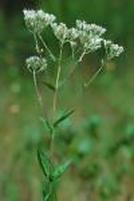
Eupatorium pilosum
Rough Boneset
Wetland Indicator: FACW
Physiographic Provinces: Appalachian Plateau, Valley and Ridge, Blue Ridge, Piedmont, Coastal Plain
Native American usage:
Used for “breast complaints”, for colds, as a laxative, as a tonic and to increase urination
Photo credit: Gary P. Fleming DCR-DNH @ vaplantatlas.org
Rough Boneset
Wetland Indicator: FACW
Physiographic Provinces: Appalachian Plateau, Valley and Ridge, Blue Ridge, Piedmont, Coastal Plain
Native American usage:
Used for “breast complaints”, for colds, as a laxative, as a tonic and to increase urination
Photo credit: Gary P. Fleming DCR-DNH @ vaplantatlas.org
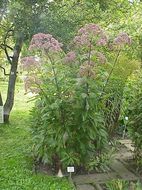
Eupatorium purpureum
Sweet Scented Joe Pye Weed
Wetland Indicator: FACW
Physiographic Provinces: Appalachian Plateau, Valley and Ridge, Blue Ridge, Piedmont, Coastal Plain
Native American usage:
Root used for rheumatism, as a diuretic, for “female troubles”, gout and dropsy
Compound decoction taken for “difficult urination”
Vapors from infusion of plant top inhaled for colds
Plant used to counteract bad effects of a miscarriage
Infusion of roots taken as a laxative
Compound decoction of root taken after childbirth “for internal healing”
Decoction taken for arrow wounds
Root used as a strengthening wash for infants
Poultice of fresh leaves applied to burns
Photo credit: Kurt Stuber @ commons.wikimedia.org
Sweet Scented Joe Pye Weed
Wetland Indicator: FACW
Physiographic Provinces: Appalachian Plateau, Valley and Ridge, Blue Ridge, Piedmont, Coastal Plain
Native American usage:
Root used for rheumatism, as a diuretic, for “female troubles”, gout and dropsy
Compound decoction taken for “difficult urination”
Vapors from infusion of plant top inhaled for colds
Plant used to counteract bad effects of a miscarriage
Infusion of roots taken as a laxative
Compound decoction of root taken after childbirth “for internal healing”
Decoction taken for arrow wounds
Root used as a strengthening wash for infants
Poultice of fresh leaves applied to burns
Photo credit: Kurt Stuber @ commons.wikimedia.org
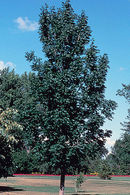
Fraxinus nigra
Black Ash
Wetland Indicator: FACW
Physiographic Provinces: Valley and Ridge, Blue Ridge, Piedmont
Native American usage:
Tonic of inner bark used for liver and stomach
Infusion of bark taken for painful urination
Compound infusion of roots and bark used as a foot soak for rheumatism
Compound infusion of roots used as ear drops
Compound decoction of bark taken as a laxative
Infusion of inner bark applied to sore eyes
Compound decoction of roots and bark used to induce pregnancy
Photo credit: public domain
Black Ash
Wetland Indicator: FACW
Physiographic Provinces: Valley and Ridge, Blue Ridge, Piedmont
Native American usage:
Tonic of inner bark used for liver and stomach
Infusion of bark taken for painful urination
Compound infusion of roots and bark used as a foot soak for rheumatism
Compound infusion of roots used as ear drops
Compound decoction of bark taken as a laxative
Infusion of inner bark applied to sore eyes
Compound decoction of roots and bark used to induce pregnancy
Photo credit: public domain
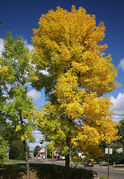
Fraxinus pennsylvanica
Green Ash
Wetland Indicator: FACW
Physiographic Provinces: Valley and Ridge, Blue Ridge, Piedmont, Coastal Plain
Native American usage:
Infusion of inner bark used for depression and for fatigue
Photo credit: Chris Hartman @ commons.wikimedia.org
Green Ash
Wetland Indicator: FACW
Physiographic Provinces: Valley and Ridge, Blue Ridge, Piedmont, Coastal Plain
Native American usage:
Infusion of inner bark used for depression and for fatigue
Photo credit: Chris Hartman @ commons.wikimedia.org
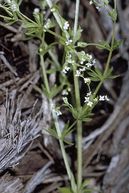
Galium asprellum
Rough Bedstraw
Wetland Indicator: OBL
Physiographic Provinces: Appalachian Plateau, Valley and Ridge, Blue Ridge, Piedmont, Coastal Plain
Native American usage:
Used as a diuretic, for measles and to cause sweating
Photo credit: public domain
Rough Bedstraw
Wetland Indicator: OBL
Physiographic Provinces: Appalachian Plateau, Valley and Ridge, Blue Ridge, Piedmont, Coastal Plain
Native American usage:
Used as a diuretic, for measles and to cause sweating
Photo credit: public domain
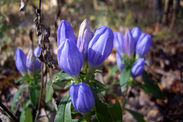
Gentiana saponaria
Soapwort Gentian
Wetland Indicator: FACW
Physiographic Provinces: Valley and Ridge, Blue Ridge, Piedmont, Coastal Plain
Native American usage:
Simple or compound decoction taken as a tonic
Photo credit: Chris Hartman @ commons.wikimedia.org
Soapwort Gentian
Wetland Indicator: FACW
Physiographic Provinces: Valley and Ridge, Blue Ridge, Piedmont, Coastal Plain
Native American usage:
Simple or compound decoction taken as a tonic
Photo credit: Chris Hartman @ commons.wikimedia.org
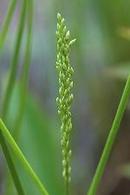
Glyceria obtusa
Atlantic Manna Grass
Wetland Indicator: OBL
Physiographic Provinces: Valley and Ridge, Blue Ridge, Piedmont, Coastal Plain
Native American usage:
Roots beaten and made into an infusion for backache
Photo credit: Gary P. Fleming DCR-DNH @ vaplantatlas.org
Atlantic Manna Grass
Wetland Indicator: OBL
Physiographic Provinces: Valley and Ridge, Blue Ridge, Piedmont, Coastal Plain
Native American usage:
Roots beaten and made into an infusion for backache
Photo credit: Gary P. Fleming DCR-DNH @ vaplantatlas.org
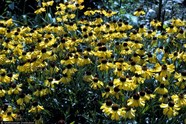
Helenium autumnale
Common Sneezeweed
Wetland Indicator: FACW+
Physiographic Provinces: Appalachian Plateau, Valley and Ridge, Blue Ridge, Piedmont, Coastal Plain
Native American usage:
Compound infusion of roots used to prevent menstruation after childbirth
Powdered dry leaves used to induce sneezing
Infusion of stems used as a wash for fever
Simple or compound snuff of flowers caused sneezing to clear a stuffy head cold
Infusion of florets taken or stomach problems
Photo credit: R.A. Howard @ USDA-NRCS PLANTS Database
Common Sneezeweed
Wetland Indicator: FACW+
Physiographic Provinces: Appalachian Plateau, Valley and Ridge, Blue Ridge, Piedmont, Coastal Plain
Native American usage:
Compound infusion of roots used to prevent menstruation after childbirth
Powdered dry leaves used to induce sneezing
Infusion of stems used as a wash for fever
Simple or compound snuff of flowers caused sneezing to clear a stuffy head cold
Infusion of florets taken or stomach problems
Photo credit: R.A. Howard @ USDA-NRCS PLANTS Database
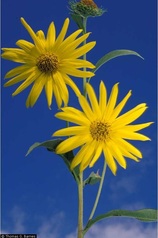
Helianthus giganteus
Tall Sunflower
Wetland Indicator: FACW
Physiographic Provinces: Appalachian Plateau, Valley and Ridge, Blue Ridge, Piedmont, Coastal Plain
Native American usage:
Dried powder used to induce sneezing
Photo credit: Thomas G. Barnes @ USDA-NRCS PLANTS Database / Barnes, T.G., and S.W. Francis. 2004. Wildflowers and ferns of Kentucky. University Press of Kentucky
Tall Sunflower
Wetland Indicator: FACW
Physiographic Provinces: Appalachian Plateau, Valley and Ridge, Blue Ridge, Piedmont, Coastal Plain
Native American usage:
Dried powder used to induce sneezing
Photo credit: Thomas G. Barnes @ USDA-NRCS PLANTS Database / Barnes, T.G., and S.W. Francis. 2004. Wildflowers and ferns of Kentucky. University Press of Kentucky
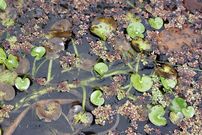
Heteranthera reniformis
Kidney Leaf Mud Plantain
Wetland Indicator: OBL
Physiographic Provinces: Valley and Ridge, Blue Ridge, Piedmont, Coastal Plain
Native American usage:
Hot root poultice applied to inflamed wounds and sores
Photo credit: Krzysztof Ziarnek @ commons.wikimedia.org
Kidney Leaf Mud Plantain
Wetland Indicator: OBL
Physiographic Provinces: Valley and Ridge, Blue Ridge, Piedmont, Coastal Plain
Native American usage:
Hot root poultice applied to inflamed wounds and sores
Photo credit: Krzysztof Ziarnek @ commons.wikimedia.org
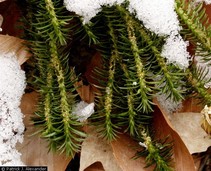
Huperzia lucidula
Shining Clubmoss
Wetland Indicator: FACW-
Physiographic Provinces: Appalachian Plateau, Valley and Ridge, Blue Ridge, Piedmont, Coastal Plain
Native American usage:
Compound used for neck sores and for when the “blood is bad”
Used by women for colds due to suppressed menstruation
Photo credit: Patrick J. Alexander @ USDA-NRCS PLANTS Database
Shining Clubmoss
Wetland Indicator: FACW-
Physiographic Provinces: Appalachian Plateau, Valley and Ridge, Blue Ridge, Piedmont, Coastal Plain
Native American usage:
Compound used for neck sores and for when the “blood is bad”
Used by women for colds due to suppressed menstruation
Photo credit: Patrick J. Alexander @ USDA-NRCS PLANTS Database
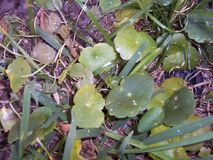
Hydrocotyle umbellate
Pennywort
Wetland Indicator: OBL
Physiographic Provinces: Piedmont, Coastal Plain
Native American usage:
Roots or plants used for “turtle sickness”: trembling short breath and cough
Photo credit: public domain
Pennywort
Wetland Indicator: OBL
Physiographic Provinces: Piedmont, Coastal Plain
Native American usage:
Roots or plants used for “turtle sickness”: trembling short breath and cough
Photo credit: public domain
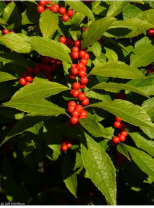
Ilex verticillata
Winterberry
Wetland Indicator: FACW+
Physiographic Provinces: Appalachian Plateau, Valley and Ridge, Blue Ridge, Piedmont, Coastal Plain
Native American usage:
Decoction of bark taken to induce vomiting, as a physic, for biliousness and for hay fever
Bark used for diarrhea
Photo credit: Jeff McMillian @ USDA-NRCS PLANTS Database
Winterberry
Wetland Indicator: FACW+
Physiographic Provinces: Appalachian Plateau, Valley and Ridge, Blue Ridge, Piedmont, Coastal Plain
Native American usage:
Decoction of bark taken to induce vomiting, as a physic, for biliousness and for hay fever
Bark used for diarrhea
Photo credit: Jeff McMillian @ USDA-NRCS PLANTS Database
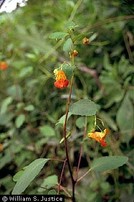
Impatiens capensis
Touch Me Not
Wetland Indicator: FACW
Physiographic Provinces: Appalachian Plateau, Valley and Ridge, Blue Ridge, Piedmont, Coastal Plain
Native American usage:
Poultice of crushed stems and leaves applied to skin for rash and eczema
Juice rubbed on sores, ivy poisoning, and mosquito bites and the head for headache
Infusion of roots used for babies with hives
Crushed leaves rubbed on children’s “sour stomach”
Decoction taken and a wash used to aid in childbirth
Infusion of leaves taken for measles and for jaundice
Compound decoction of plants taken and used as a wash for liver spots
Infusion of roots taken as a diuretic
Poultice of smashed stems applied to sore or raw eyelids
Cold infusion taken for fever
Infusion of plant used for liniment for sprains or bruises and for stomach cramps
Poultice of crushed buds applied to burns
Photo credit: William S. Justice @ USDA-NRCS PLANTS Database
Touch Me Not
Wetland Indicator: FACW
Physiographic Provinces: Appalachian Plateau, Valley and Ridge, Blue Ridge, Piedmont, Coastal Plain
Native American usage:
Poultice of crushed stems and leaves applied to skin for rash and eczema
Juice rubbed on sores, ivy poisoning, and mosquito bites and the head for headache
Infusion of roots used for babies with hives
Crushed leaves rubbed on children’s “sour stomach”
Decoction taken and a wash used to aid in childbirth
Infusion of leaves taken for measles and for jaundice
Compound decoction of plants taken and used as a wash for liver spots
Infusion of roots taken as a diuretic
Poultice of smashed stems applied to sore or raw eyelids
Cold infusion taken for fever
Infusion of plant used for liniment for sprains or bruises and for stomach cramps
Poultice of crushed buds applied to burns
Photo credit: William S. Justice @ USDA-NRCS PLANTS Database
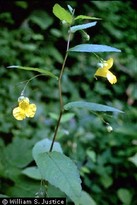
Impatiens pallida
Spotted Touch Me Not
Wetland Indicator: FACW
Physiographic Provinces: Appalachian Plateau, Valley and Ridge, Blue Ridge, Piedmont, Coastal Plain
Native American usage:
Poultice of crushed stems and leaves applied to skin for rash and eczema
Juice rubbed on sores, ivy poisoning, and mosquito bites
Infusion of roots used for babies with hives
Crushed leaves rubbed on children’s “sour stomach”
Decoction taken and a wash used to aid in childbirth
Infusion of leaves taken for measles
Cold infusion taken for fever
Poultice applied to breast injuries
Photo credit: William S. Justice @ USDA-NRCS PLANTS Database
Spotted Touch Me Not
Wetland Indicator: FACW
Physiographic Provinces: Appalachian Plateau, Valley and Ridge, Blue Ridge, Piedmont, Coastal Plain
Native American usage:
Poultice of crushed stems and leaves applied to skin for rash and eczema
Juice rubbed on sores, ivy poisoning, and mosquito bites
Infusion of roots used for babies with hives
Crushed leaves rubbed on children’s “sour stomach”
Decoction taken and a wash used to aid in childbirth
Infusion of leaves taken for measles
Cold infusion taken for fever
Poultice applied to breast injuries
Photo credit: William S. Justice @ USDA-NRCS PLANTS Database
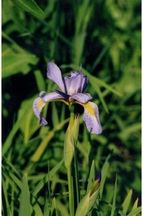
Iris versicolor
Blue Flag
Wetland Indicator: OBL
Physiographic Provinces: Valley and Ridge, Blue Ridge, Piedmont, Coastal Plain
Native American usage:
Poultice of smashed roots applied to burns and wounds
Poultice of root applied to swelling, sores
Plant used to increase bile flow
Roots used for rheumatism, kidney disorders, liver disorders, scrofula, cold, lung trouble
Root used for cholera
Poultice of crushed rhizomes applied for blood poisoning caused by contusions
Poultice of plant and flour applied to painful sites
Pulverized root mixed with water and used for earache and to medicate eye water
Infusion of smashed roots taken to induce pregnancy
Compound decoction with roots taken for hay fever
Photo credit: Jennifer Anderson @ USDA-NRCS PLANTS Database
Blue Flag
Wetland Indicator: OBL
Physiographic Provinces: Valley and Ridge, Blue Ridge, Piedmont, Coastal Plain
Native American usage:
Poultice of smashed roots applied to burns and wounds
Poultice of root applied to swelling, sores
Plant used to increase bile flow
Roots used for rheumatism, kidney disorders, liver disorders, scrofula, cold, lung trouble
Root used for cholera
Poultice of crushed rhizomes applied for blood poisoning caused by contusions
Poultice of plant and flour applied to painful sites
Pulverized root mixed with water and used for earache and to medicate eye water
Infusion of smashed roots taken to induce pregnancy
Compound decoction with roots taken for hay fever
Photo credit: Jennifer Anderson @ USDA-NRCS PLANTS Database
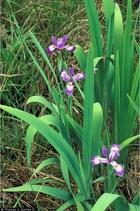
Iris virginica
Virginia Blue Flag
Wetland Indicator: OBL
Physiographic Provinces: Valley and Ridge, Blue Ridge, Piedmont, Coastal Plain
Native American usage:
Root pulverized and compounded into a decoction and made into a salve for ulcers
Infusion taken for the liver
Root compounded into a decoction for “yellowish” urine
Photo credit: Thomas G. Barnes @ USDA-NRCS PLANTS Database / Barnes, T.G., and S.W. Francis. 2004. Wildflowers and ferns of Kentucky. University Press of Kentucky
Virginia Blue Flag
Wetland Indicator: OBL
Physiographic Provinces: Valley and Ridge, Blue Ridge, Piedmont, Coastal Plain
Native American usage:
Root pulverized and compounded into a decoction and made into a salve for ulcers
Infusion taken for the liver
Root compounded into a decoction for “yellowish” urine
Photo credit: Thomas G. Barnes @ USDA-NRCS PLANTS Database / Barnes, T.G., and S.W. Francis. 2004. Wildflowers and ferns of Kentucky. University Press of Kentucky
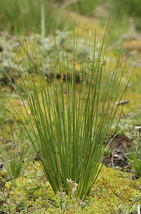
Juncus effuses
Soft Rush
Wetland Indicator: FACW+
Physiographic Provinces: Appalachian Plateau, Valley and Ridge, Blue Ridge, Piedmont, Coastal Plain
Native American usage:
Decoction taken to induce vomiting and to “dislodge spoiled saliva”
Infusion used as a wash to prevent lameness in children and to strength babies
Photo credit: James Lindsey at Ecology of Commanstart @ commons.wikimedia.org
Soft Rush
Wetland Indicator: FACW+
Physiographic Provinces: Appalachian Plateau, Valley and Ridge, Blue Ridge, Piedmont, Coastal Plain
Native American usage:
Decoction taken to induce vomiting and to “dislodge spoiled saliva”
Infusion used as a wash to prevent lameness in children and to strength babies
Photo credit: James Lindsey at Ecology of Commanstart @ commons.wikimedia.org
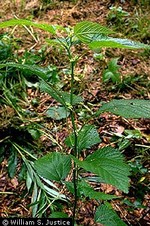
Laportea Canadensis
Canada Wood Nettle
Wetland Indicator: FACW
Physiographic Provinces: Appalachian Plateau, Valley and Ridge, Blue Ridge, Piedmont, Coastal Plain
Native American usage:
Decoction taken for fever
Infusion of smashed roots taken to help childbirth and for tuberculosis
Infusion of roots used as a diuretic, for incontinence and other urinary ailments
Photo credit: William S. Justice @ USDA-NRCS PLANTS Database
Canada Wood Nettle
Wetland Indicator: FACW
Physiographic Provinces: Appalachian Plateau, Valley and Ridge, Blue Ridge, Piedmont, Coastal Plain
Native American usage:
Decoction taken for fever
Infusion of smashed roots taken to help childbirth and for tuberculosis
Infusion of roots used as a diuretic, for incontinence and other urinary ailments
Photo credit: William S. Justice @ USDA-NRCS PLANTS Database
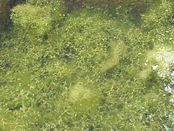
Lemna trisulca
Duckweed (Trisulca)
Wetland Indicator: OBL
Physiographic Provinces: Valley and Ridge, Blue Ridge, Coastal Plain
Native American usage:
Poultice of wet plant (along with other plants) applied to swellings
Photo credit: GFDL @ commons.wikimedia.org
Duckweed (Trisulca)
Wetland Indicator: OBL
Physiographic Provinces: Valley and Ridge, Blue Ridge, Coastal Plain
Native American usage:
Poultice of wet plant (along with other plants) applied to swellings
Photo credit: GFDL @ commons.wikimedia.org
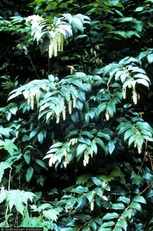
Leucothoe xillaris
Dog Hobble
Wetland Indicator: FACW+
Physiographic Provinces: Coastal Plain
Native American usage:
Infusion used for “shifting pains”
Compound decoction of leaf used for rheumatism
Infusion of leaves and stems used to treat itches from scratches
Photo credit: R.A. Howard @ USDA-NRCS PLANTS Database
Dog Hobble
Wetland Indicator: FACW+
Physiographic Provinces: Coastal Plain
Native American usage:
Infusion used for “shifting pains”
Compound decoction of leaf used for rheumatism
Infusion of leaves and stems used to treat itches from scratches
Photo credit: R.A. Howard @ USDA-NRCS PLANTS Database
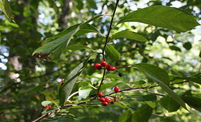
Lindera benzoin
Spicebush
Wetland Indicator: FACW-
Physiographic Provinces: Appalachian Plateau, Valley and Ridge, Blue Ridge, Piedmont, Coastal Plain
Native American usage:
Taken for female problems
Taken for colds, coughs and croup
Infusion of bark taken for measles
Plant used to induce vomiting
Infusion of branches taken and steam bath used to cause sweating to relieve aches
Compound decoction of roots taken for gonorrhea and syphilis
Photo credit: Cody Hough college student and photographer in the Michigan area @ commons.wikimedia.org
Spicebush
Wetland Indicator: FACW-
Physiographic Provinces: Appalachian Plateau, Valley and Ridge, Blue Ridge, Piedmont, Coastal Plain
Native American usage:
Taken for female problems
Taken for colds, coughs and croup
Infusion of bark taken for measles
Plant used to induce vomiting
Infusion of branches taken and steam bath used to cause sweating to relieve aches
Compound decoction of roots taken for gonorrhea and syphilis
Photo credit: Cody Hough college student and photographer in the Michigan area @ commons.wikimedia.org
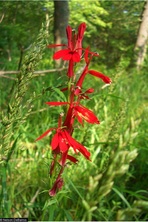
Lobelia cardinalis
Cardinal Flower
Wetland Indicator: FACW+
Physiographic Provinces: Appalachian Plateau, Valley and Ridge, Blue Ridge, Piedmont, Coastal Plain
Native American usage:
Compound taken for pain, poultice of crushed leaves used for headache
Infusion of roots taken for worms and for stomach trouble
Infusion of leaf taken for colds and fever
Infusion snuffed to stop nosebleed
Used to treat croup and syphilis
Infusion of root used to treat typhoid
Infusion given for rheumatism
Decoction or infusion taken and poultice or wash used for breast troubles
Photo credit: Nelson DeBarros @ USDA-NRCS PLANTS Database
Cardinal Flower
Wetland Indicator: FACW+
Physiographic Provinces: Appalachian Plateau, Valley and Ridge, Blue Ridge, Piedmont, Coastal Plain
Native American usage:
Compound taken for pain, poultice of crushed leaves used for headache
Infusion of roots taken for worms and for stomach trouble
Infusion of leaf taken for colds and fever
Infusion snuffed to stop nosebleed
Used to treat croup and syphilis
Infusion of root used to treat typhoid
Infusion given for rheumatism
Decoction or infusion taken and poultice or wash used for breast troubles
Photo credit: Nelson DeBarros @ USDA-NRCS PLANTS Database
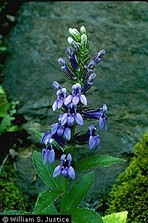
Lobelia siphilitica
Great Blue Lobelia
Wetland Indicator: FACW+
Physiographic Provinces: Appalachian Plateau, Valley and Ridge, Blue Ridge, Piedmont, Coastal Plain
Native American usage:
Compound taken for pain, poultice of crushed leaves used for headache
Infusion of roots taken for worms and for stomach trouble
Infusion given for rheumatism
Infusion of leaf taken for colds and fever
Used to treat croup and syphilis
Infusion snuffed to stop nosebleed
Used for croup and syphilis
Photo credit: William S. Justice @ USDA-NRCS PLANTS Database
Great Blue Lobelia
Wetland Indicator: FACW+
Physiographic Provinces: Appalachian Plateau, Valley and Ridge, Blue Ridge, Piedmont, Coastal Plain
Native American usage:
Compound taken for pain, poultice of crushed leaves used for headache
Infusion of roots taken for worms and for stomach trouble
Infusion given for rheumatism
Infusion of leaf taken for colds and fever
Used to treat croup and syphilis
Infusion snuffed to stop nosebleed
Used for croup and syphilis
Photo credit: William S. Justice @ USDA-NRCS PLANTS Database
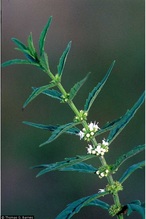
Lycopus americanus
American Bugleweed
Wetland Indicator: OBL
Physiographic Provinces: Valley and Ridge, Blue Ridge, Piedmont, Coastal Plain
Native American usage:
Compound of plant used for stomach cramps
Photo credit: Thomas G. Barnes @ USDA-NRCS PLANTS Database / Barnes, T.G., and S.W. Francis. 2004. Wildflowers and ferns of Kentucky. University Press of Kentucky.
American Bugleweed
Wetland Indicator: OBL
Physiographic Provinces: Valley and Ridge, Blue Ridge, Piedmont, Coastal Plain
Native American usage:
Compound of plant used for stomach cramps
Photo credit: Thomas G. Barnes @ USDA-NRCS PLANTS Database / Barnes, T.G., and S.W. Francis. 2004. Wildflowers and ferns of Kentucky. University Press of Kentucky.
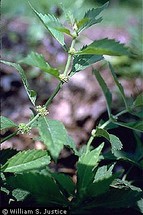
Lycopus virginicus
Virginia Bugleweed
Wetland Indicator: OBL
Physiographic Provinces: Appalachian Plateau, Valley and Ridge, Blue Ridge, Piedmont, Coastal Plain
Native American usage:
Root chewed and given to infants to give the “eloquence of speech”
Root portion chewed and swallowed then remainder applied to snakebite wound
Some groups consider the leaves and roots poisonous
Photo credit: William S. Justice @ USDA-NRCS PLANTS Database
Virginia Bugleweed
Wetland Indicator: OBL
Physiographic Provinces: Appalachian Plateau, Valley and Ridge, Blue Ridge, Piedmont, Coastal Plain
Native American usage:
Root chewed and given to infants to give the “eloquence of speech”
Root portion chewed and swallowed then remainder applied to snakebite wound
Some groups consider the leaves and roots poisonous
Photo credit: William S. Justice @ USDA-NRCS PLANTS Database
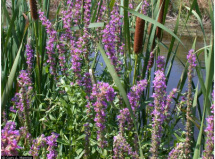
Lythrum salicaria
Purple Loosestrife
Wetland Indicator: FACW+
Physiographic Provinces: Appalachian Plateau, Valley and Ridge, Blue Ridge, Piedmont, Coastal Plain
Native American usage:
Compound decoction taken for fever
Photo credit: Gary A. Monroe @ USDA-NRCS PLANTS Database
Purple Loosestrife
Wetland Indicator: FACW+
Physiographic Provinces: Appalachian Plateau, Valley and Ridge, Blue Ridge, Piedmont, Coastal Plain
Native American usage:
Compound decoction taken for fever
Photo credit: Gary A. Monroe @ USDA-NRCS PLANTS Database
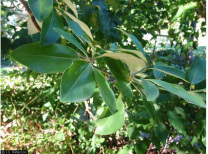
Magnolia virginiana
Sweet Bay
Wetland Indicator: FACW+
Physiographic Provinces: Valley and Ridge, Blue Ridge, Piedmont, Coastal Plain
Native American usage:
Decoction of leaves and twigs taken for colds and chills and to “warm the blood"
Photo credit: J.S. Peterson @ USDA-NRCS PLANTS Database
Sweet Bay
Wetland Indicator: FACW+
Physiographic Provinces: Valley and Ridge, Blue Ridge, Piedmont, Coastal Plain
Native American usage:
Decoction of leaves and twigs taken for colds and chills and to “warm the blood"
Photo credit: J.S. Peterson @ USDA-NRCS PLANTS Database
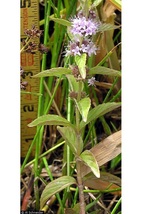
Mentha arvensis
Field Mint
Wetland Indicator: FACW
Physiographic Provinces: Valley and Ridge, Blue Ridge, Piedmont, Coastal Plain
Native American usage:
Infusion taken for colds, coughs, fever, headache and as a general tonic, compound infusion applied to chest for pneumonia
Infusion of leaves taken for kidney complaints
Infusion of ground leaves and stems taken to induce vomiting and to strengthen heart muscles
Poultice of leaves and stems applied to painful areas, areas of swelling
Poultice of leaves used for rheumatism and arthritis
Cold infusion ingested and used as a lotion for influenza
Infusion of stems given to children for colic
Photo credit: Al Schneider @ USDA-NRCS PLANTS Database
Field Mint
Wetland Indicator: FACW
Physiographic Provinces: Valley and Ridge, Blue Ridge, Piedmont, Coastal Plain
Native American usage:
Infusion taken for colds, coughs, fever, headache and as a general tonic, compound infusion applied to chest for pneumonia
Infusion of leaves taken for kidney complaints
Infusion of ground leaves and stems taken to induce vomiting and to strengthen heart muscles
Poultice of leaves and stems applied to painful areas, areas of swelling
Poultice of leaves used for rheumatism and arthritis
Cold infusion ingested and used as a lotion for influenza
Infusion of stems given to children for colic
Photo credit: Al Schneider @ USDA-NRCS PLANTS Database
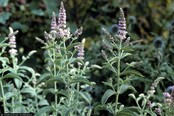
Mentha spicata
Spearmint
Wetland Indicator: FACW+
Physiographic Provinces: Valley and Ridge, Blue Ridge, Piedmont, Coastal Plain
Native American usage:
Used to flavor medicines
Taken for colic pains, cramps, headaches
Taken to stop vomiting and for bowel problems
Infusion taken for fevers and as a cold remedy and given to children for a bad stomach
Tincture applied to hemorrhoids
Cold infusion applied to forehead and taken as a cold remedy
Compound infusion of powdered plants taken for typhoid
Compound decoction of roots and berries taken for hay fever
Infusion of leaves taken for diarrhea
Infusion of plant taken as worming medicine
Photo credit: R.A. Howard @ USDA-NRCS PLANTS Database
Spearmint
Wetland Indicator: FACW+
Physiographic Provinces: Valley and Ridge, Blue Ridge, Piedmont, Coastal Plain
Native American usage:
Used to flavor medicines
Taken for colic pains, cramps, headaches
Taken to stop vomiting and for bowel problems
Infusion taken for fevers and as a cold remedy and given to children for a bad stomach
Tincture applied to hemorrhoids
Cold infusion applied to forehead and taken as a cold remedy
Compound infusion of powdered plants taken for typhoid
Compound decoction of roots and berries taken for hay fever
Infusion of leaves taken for diarrhea
Infusion of plant taken as worming medicine
Photo credit: R.A. Howard @ USDA-NRCS PLANTS Database
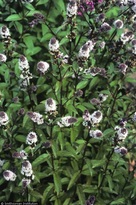
Mentha x piperita
Pepper Mint
Wetland Indicator: FACW+
Physiographic Provinces: Appalachian Plateau, Valley and Ridge, Blue Ridge, Piedmont, Coastal Plain
Native American usage:
Used to flavor medicine
Taken for fevers, colds, for colic pains, cramps, for headache and for urinary problems
Infusion of plant used by children and adults for worms
Taken to stop vomiting and for bowel problems
Tincture applied to hemorrhoids
Compound infusion taken and applied to chest for pneumonia
Given for cholera infantum
Photo credit: R.A. Howard @ USDA-NRCS PLANTS Database
Pepper Mint
Wetland Indicator: FACW+
Physiographic Provinces: Appalachian Plateau, Valley and Ridge, Blue Ridge, Piedmont, Coastal Plain
Native American usage:
Used to flavor medicine
Taken for fevers, colds, for colic pains, cramps, for headache and for urinary problems
Infusion of plant used by children and adults for worms
Taken to stop vomiting and for bowel problems
Tincture applied to hemorrhoids
Compound infusion taken and applied to chest for pneumonia
Given for cholera infantum
Photo credit: R.A. Howard @ USDA-NRCS PLANTS Database
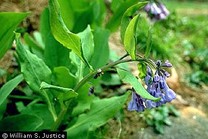
Mertensia virginica
Virginia Bluebells
Wetland Indicator: FACW
Physiographic Provinces: Appalachian Plateau, Valley and Ridge, Blue Ridge, Piedmont, Coastal Plain
Native American usage:
Taken for whooping cough and tuberculosis
Decoction of roots taken for venereal disease
Photo credit: William S. Justice @ USDA-NRCS PLANTS Database
Virginia Bluebells
Wetland Indicator: FACW
Physiographic Provinces: Appalachian Plateau, Valley and Ridge, Blue Ridge, Piedmont, Coastal Plain
Native American usage:
Taken for whooping cough and tuberculosis
Decoction of roots taken for venereal disease
Photo credit: William S. Justice @ USDA-NRCS PLANTS Database
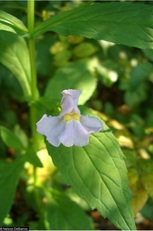
Mimulus ringens
Monkey Flower
Wetland Indicator: OBL
Physiographic Provinces: Appalachian Plateau, Valley and Ridge, Blue Ridge, Piedmont, Coastal Plain
Native American usage:
Compound decoction of roots taken by women for epilepsy
Photo credit: Nelson DeBarros @ USDA-NRCS PLANTS Database
Monkey Flower
Wetland Indicator: OBL
Physiographic Provinces: Appalachian Plateau, Valley and Ridge, Blue Ridge, Piedmont, Coastal Plain
Native American usage:
Compound decoction of roots taken by women for epilepsy
Photo credit: Nelson DeBarros @ USDA-NRCS PLANTS Database
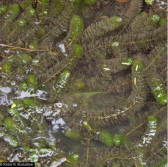
Myriophyllum spicatum
Common Milfoil
Wetland Indicator: OBL
Physiographic Provinces: Valley and Ridge, Blue Ridge, Piedmont, Coastal Plain
Native American usage:
Plant used by some groups for unspecified reasons
Photo credit: Robin R. Buckallew @ USDA-NRCS PLANTS Database
Common Milfoil
Wetland Indicator: OBL
Physiographic Provinces: Valley and Ridge, Blue Ridge, Piedmont, Coastal Plain
Native American usage:
Plant used by some groups for unspecified reasons
Photo credit: Robin R. Buckallew @ USDA-NRCS PLANTS Database
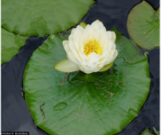
Nymphaea odorata
White Waterlily
Wetland Indicator: OBL
Physiographic Provinces: Valley and Ridge, Blue Ridge, Piedmont, Coastal Plain
Native American usage:
Dried, pulverized roots used for mouth sores, stems placed on tooth for toothache
Leaves used for colds
Juice of root taken for coughs
Poultice of boiled root or compound poultice of mashed leaves applied to swellings
Stems placed directly on tooth for toothache
Roots used as cough medicine for tuberculosis
Photo credit: Robin R. Buckallew @ USDA-NRCS PLANTS Database
White Waterlily
Wetland Indicator: OBL
Physiographic Provinces: Valley and Ridge, Blue Ridge, Piedmont, Coastal Plain
Native American usage:
Dried, pulverized roots used for mouth sores, stems placed on tooth for toothache
Leaves used for colds
Juice of root taken for coughs
Poultice of boiled root or compound poultice of mashed leaves applied to swellings
Stems placed directly on tooth for toothache
Roots used as cough medicine for tuberculosis
Photo credit: Robin R. Buckallew @ USDA-NRCS PLANTS Database
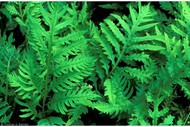
Onoclea sensibilis
Onoclea
Wetland Indicator: FACW
Physiographic Provinces: Appalachian Plateau, Valley and Ridge, Blue Ridge, Piedmont, Coastal Plain
Native American usage:
Used for arthritis and infection
Poultice of plant top used for deep cuts
Used for intestinal trouble
Infusion of plant taken for pain after childbirth and to promote milk flow
Compound decoction of roots taken in early stages of tuberculosis and for venereal disease
Photo credit: Thomas G. Barnes @ USDA-NRCS PLANTS Database / Barnes, T.G., and S.W. Francis. 2004. Wildflowers and ferns of Kentucky. University Press of Kentucky.
Onoclea
Wetland Indicator: FACW
Physiographic Provinces: Appalachian Plateau, Valley and Ridge, Blue Ridge, Piedmont, Coastal Plain
Native American usage:
Used for arthritis and infection
Poultice of plant top used for deep cuts
Used for intestinal trouble
Infusion of plant taken for pain after childbirth and to promote milk flow
Compound decoction of roots taken in early stages of tuberculosis and for venereal disease
Photo credit: Thomas G. Barnes @ USDA-NRCS PLANTS Database / Barnes, T.G., and S.W. Francis. 2004. Wildflowers and ferns of Kentucky. University Press of Kentucky.
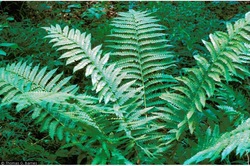
Osmunda cinnamomea
Cinnamon Fern
Wetland Indicator: FACW
Physiographic Provinces: Appalachian Plateau, Valley and Ridge, Blue Ridge, Piedmont, Coastal Plain
Native American usage:
Compound of roots rubbed on areas affected by rheumatism, also used for chills
Root chewed and applied to snakebite
Decoction taken for headache and joint pain and colds
Roots used for “women’s problems” and to promote milk flow
Cold compound used as a wash and a decoction taken for venereal disease
Photo credit: public domain
Cinnamon Fern
Wetland Indicator: FACW
Physiographic Provinces: Appalachian Plateau, Valley and Ridge, Blue Ridge, Piedmont, Coastal Plain
Native American usage:
Compound of roots rubbed on areas affected by rheumatism, also used for chills
Root chewed and applied to snakebite
Decoction taken for headache and joint pain and colds
Roots used for “women’s problems” and to promote milk flow
Cold compound used as a wash and a decoction taken for venereal disease
Photo credit: public domain
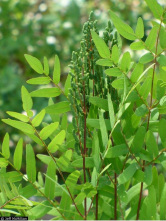
Osmunda regalis var. spectabilis
Royal Fern
Wetland Indicator: OBL
Physiographic Provinces: Appalachian Plateau, Valley and Ridge, Blue Ridge, Piedmont, Coastal Plain
Native American usage:
Infusion of fronds and wild ginger rhizome used to treat children suffering from intestinal worms
Decoction taken by women for “watery blood”, for strong menses and for kidney colds
Plant used for chronically sick babies
Photo credit: Jeff McMillian @ USDA-NRCS PLANTS Database
Royal Fern
Wetland Indicator: OBL
Physiographic Provinces: Appalachian Plateau, Valley and Ridge, Blue Ridge, Piedmont, Coastal Plain
Native American usage:
Infusion of fronds and wild ginger rhizome used to treat children suffering from intestinal worms
Decoction taken by women for “watery blood”, for strong menses and for kidney colds
Plant used for chronically sick babies
Photo credit: Jeff McMillian @ USDA-NRCS PLANTS Database
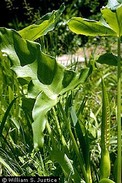
Peltandra virginica
Arrow arum
Wetland Indicator: OBL
Physiographic Provinces: Valley and Ridge, Blue Ridge, Piedmont, Coastal Plain
Native American usage:
Root grated into milk and given to babies for an unspecified purpose
Photo credit: William S. Justice @ USDA-NRCS PLANTS Database
Arrow arum
Wetland Indicator: OBL
Physiographic Provinces: Valley and Ridge, Blue Ridge, Piedmont, Coastal Plain
Native American usage:
Root grated into milk and given to babies for an unspecified purpose
Photo credit: William S. Justice @ USDA-NRCS PLANTS Database
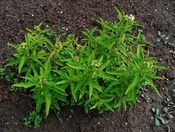
Penthorum sedoides
Stonecrop ditch
Wetland Indicator: OBL
Physiographic Provinces: Appalachian Plateau, Valley and Ridge, Blue Ridge, Piedmont, Coastal Plain
Native American usage:
Seeds used to make a cough syrup
Photo credit: H Zell @ commons.wikimedia.org
Stonecrop ditch
Wetland Indicator: OBL
Physiographic Provinces: Appalachian Plateau, Valley and Ridge, Blue Ridge, Piedmont, Coastal Plain
Native American usage:
Seeds used to make a cough syrup
Photo credit: H Zell @ commons.wikimedia.org
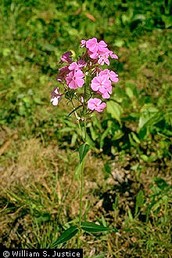
Phlox maculata
Meadow Phlox
Wetland Indicator: FACW
Physiographic Provinces: Appalachian Plateau, Valley and Ridge, Blue Ridge, Piedmont, Coastal Plain
Native American usage:
Infusion of roots made into a wash to encourage a child’s growth
Photo credit: William S. Justice @ USDA-NRCS PLANTS Database
Meadow Phlox
Wetland Indicator: FACW
Physiographic Provinces: Appalachian Plateau, Valley and Ridge, Blue Ridge, Piedmont, Coastal Plain
Native American usage:
Infusion of roots made into a wash to encourage a child’s growth
Photo credit: William S. Justice @ USDA-NRCS PLANTS Database
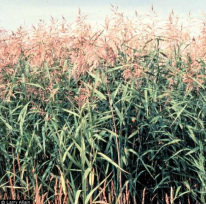
Phragmites australis
Common Reed
Wetland Indicator: FACW
Physiographic Provinces: Appalachian Plateau, Valley and Ridge, Blue Ridge, Piedmont, Coastal Plain
Native American usage:
Root used for diarrhea, stomach troubles
Decoction of plant taken to induce vomiting
Crushed plant given to children for diarrhea
Sugary sap taken by pneumonia patients to loosen phlegm and soothe lung pain
Poultice of plant applied to boils and carbuncles
Photo credit: Larry Allain @ USDA-NRCS PLANTS Database
Common Reed
Wetland Indicator: FACW
Physiographic Provinces: Appalachian Plateau, Valley and Ridge, Blue Ridge, Piedmont, Coastal Plain
Native American usage:
Root used for diarrhea, stomach troubles
Decoction of plant taken to induce vomiting
Crushed plant given to children for diarrhea
Sugary sap taken by pneumonia patients to loosen phlegm and soothe lung pain
Poultice of plant applied to boils and carbuncles
Photo credit: Larry Allain @ USDA-NRCS PLANTS Database
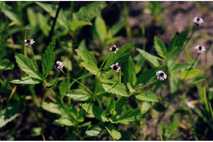
Phyla lanceolata
Lance Leaf Frog Fruit
Wetland Indicator: OBL
Physiographic Provinces: Appalachian Plateau, Valley and Ridge, Blue Ridge, Piedmont, Coastal Plain
Native American usage:
Plant used for rheumatism
Photo credit: Jennifer Anderson @ USDA-NRCS PLANTS Database
Lance Leaf Frog Fruit
Wetland Indicator: OBL
Physiographic Provinces: Appalachian Plateau, Valley and Ridge, Blue Ridge, Piedmont, Coastal Plain
Native American usage:
Plant used for rheumatism
Photo credit: Jennifer Anderson @ USDA-NRCS PLANTS Database
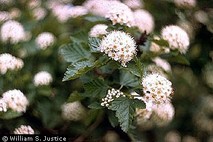
Physocarpus opulifolius
Eastern Ninebark
Wetland Indicator: FACW-
Physiographic Provinces: Appalachian Plateau, Valley and Ridge, Blue Ridge, Piedmont, Coastal Plain
Native American usage:
Decoction of inner bark taken to induce vomiting
Decoction of inner bark taken as a laxative for gonorrhea, as a wash for scrofulous neck glands
Bark used to make a drink for female maladies
Photo credit: William S. Justice @ USDA-NRCS PLANTS Database
Eastern Ninebark
Wetland Indicator: FACW-
Physiographic Provinces: Appalachian Plateau, Valley and Ridge, Blue Ridge, Piedmont, Coastal Plain
Native American usage:
Decoction of inner bark taken to induce vomiting
Decoction of inner bark taken as a laxative for gonorrhea, as a wash for scrofulous neck glands
Bark used to make a drink for female maladies
Photo credit: William S. Justice @ USDA-NRCS PLANTS Database
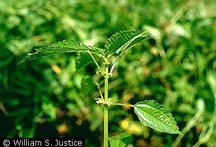
Pilea pumila
Canadian Clearweed
Wetland Indicator: FACW
Physiographic Provinces: Appalachian Plateau, Valley and Ridge, Blue Ridge, Piedmont, Coastal Plain
Native American usage:
Stems rubbed between toes for itching
Infusion given to children to suppress appetite
Stem squeezed and the “water” inhaled for sinus troubles
Photo credit: William S. Justice @ USDA-NRCS PLANTS Database
Canadian Clearweed
Wetland Indicator: FACW
Physiographic Provinces: Appalachian Plateau, Valley and Ridge, Blue Ridge, Piedmont, Coastal Plain
Native American usage:
Stems rubbed between toes for itching
Infusion given to children to suppress appetite
Stem squeezed and the “water” inhaled for sinus troubles
Photo credit: William S. Justice @ USDA-NRCS PLANTS Database
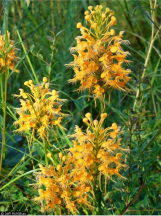
Platanthera ciliaris
Yellow Fringe Orchid
Wetland Indicator: FACW
Physiographic Provinces: Appalachian Plateau, Valley and Ridge, Blue Ridge, Piedmont, Coastal Plain
Native American usage:
Cold infusion used for headache
Infusion of root taken for diarrhea
Roots used for snakebite
Photo credit: Jeff McMillian @ USDA-NRCS PLANTS Database
Yellow Fringe Orchid
Wetland Indicator: FACW
Physiographic Provinces: Appalachian Plateau, Valley and Ridge, Blue Ridge, Piedmont, Coastal Plain
Native American usage:
Cold infusion used for headache
Infusion of root taken for diarrhea
Roots used for snakebite
Photo credit: Jeff McMillian @ USDA-NRCS PLANTS Database
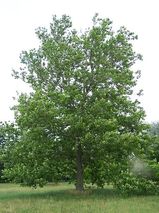
Platanus occidentalis
Sycamore
Wetland Indicator: FACW-
Physiographic Provinces: Appalachian Plateau, Valley and Ridge, Blue Ridge, Piedmont, Coastal Plain
Native American usage:
Infusion of inner bark taken for dysentery, cough, measles, difficult urination, colds
Bark used for lung troubles, hemorrhages, internal pain, pulmonary tuberculosis
Compound decoction taken by women to ease menstrual problems and to expel afterbirth
Bark used as a wash for infected sores and infusion given for infant rash
Compound used in steam bath for indigestion
Compound infusion of bark and roots used as foot wash for rheumatism
Photo credit: Gary A. Monroe @ USDA-NRCS PLANTS Database
Sycamore
Wetland Indicator: FACW-
Physiographic Provinces: Appalachian Plateau, Valley and Ridge, Blue Ridge, Piedmont, Coastal Plain
Native American usage:
Infusion of inner bark taken for dysentery, cough, measles, difficult urination, colds
Bark used for lung troubles, hemorrhages, internal pain, pulmonary tuberculosis
Compound decoction taken by women to ease menstrual problems and to expel afterbirth
Bark used as a wash for infected sores and infusion given for infant rash
Compound used in steam bath for indigestion
Compound infusion of bark and roots used as foot wash for rheumatism
Photo credit: Gary A. Monroe @ USDA-NRCS PLANTS Database
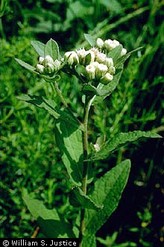
Pluchea foetida
Stinking Camphorweed
Wetland Indicator: FACW+
Physiographic Provinces: Piedmont, Coastal Plain
Native American usage:
Decoction of leaves used for fever
Photo credit: William S. Justice @ USDA-NRCS PLANTS Database
Stinking Camphorweed
Wetland Indicator: FACW+
Physiographic Provinces: Piedmont, Coastal Plain
Native American usage:
Decoction of leaves used for fever
Photo credit: William S. Justice @ USDA-NRCS PLANTS Database
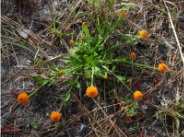
Polygala lutea
Orange Milkwort
Wetland Indicator: FACW+
Physiographic Provinces: Piedmont, Coastal Plain
Native American usage:
Poultice of dried blossoms mixed with water applied to swellings
Plant used for “sapiyi sickness”: heart palpitations, yellow skin, body swellings, and short breath
Complex infusion of plant taken for chronic conditions
Photo credit: Erica Asai @ USDA-NRCS PLANTS Database
Orange Milkwort
Wetland Indicator: FACW+
Physiographic Provinces: Piedmont, Coastal Plain
Native American usage:
Poultice of dried blossoms mixed with water applied to swellings
Plant used for “sapiyi sickness”: heart palpitations, yellow skin, body swellings, and short breath
Complex infusion of plant taken for chronic conditions
Photo credit: Erica Asai @ USDA-NRCS PLANTS Database
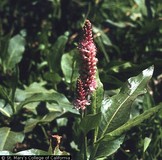
Polygonum amphibium
Water Smartweed
Wetland Indicator: OBL
Physiographic Provinces: Valley and Ridge, Blue Ridge, Piedmont
Native American usage:
Poultice of fresh roots applied to mouth blisters
Powdered roots added to many herb remedies
Infusion of dried, pounded roots taken raw or raw root eaten for chest cold
Photo credit: Brother Alfred Brousseau @ USDA-NRCS PLANTS Database
Water Smartweed
Wetland Indicator: OBL
Physiographic Provinces: Valley and Ridge, Blue Ridge, Piedmont
Native American usage:
Poultice of fresh roots applied to mouth blisters
Powdered roots added to many herb remedies
Infusion of dried, pounded roots taken raw or raw root eaten for chest cold
Photo credit: Brother Alfred Brousseau @ USDA-NRCS PLANTS Database
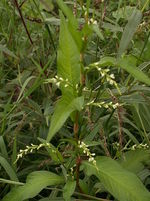
Polygonum hydropiper
Marshpepper Smartweed
Wetland Indicator: OBL
Physiographic Provinces: Appalachian Plateau, Valley and Ridge, Blue Ridge, Piedmont, Coastal Plain
Native American usage:
Taken for painful urination
Infusion mixed with meal and used as a poultice for pain
Infusion of root given to children for diarrhea
Poultice of wet plants applied to forehead for headaches
Decoction of plant taken for fever and chills and for indigestion
Whole plant used for children with swollen stomachs
Photo credit: user:Aroche @ commons.wikimedia.org
Marshpepper Smartweed
Wetland Indicator: OBL
Physiographic Provinces: Appalachian Plateau, Valley and Ridge, Blue Ridge, Piedmont, Coastal Plain
Native American usage:
Taken for painful urination
Infusion mixed with meal and used as a poultice for pain
Infusion of root given to children for diarrhea
Poultice of wet plants applied to forehead for headaches
Decoction of plant taken for fever and chills and for indigestion
Whole plant used for children with swollen stomachs
Photo credit: user:Aroche @ commons.wikimedia.org
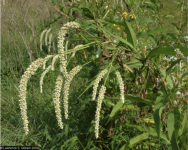
Polygonum lapathifolium
Willow Weed
Wetland Indicator: FACW+
Physiographic Provinces: Valley and Ridge, Blue Ridge, Piedmont, Coastal Plain
Native American usage:
Infusion of plant taken for stomach trouble, fever and to induce vomiting
Photo credit: Stan Gilliam @ USDA-NRCS PLANTS Database
Willow Weed
Wetland Indicator: FACW+
Physiographic Provinces: Valley and Ridge, Blue Ridge, Piedmont, Coastal Plain
Native American usage:
Infusion of plant taken for stomach trouble, fever and to induce vomiting
Photo credit: Stan Gilliam @ USDA-NRCS PLANTS Database
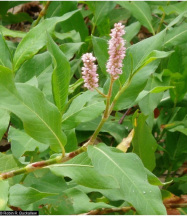
Polygonum pennsylvanicum
Pennsylvania Smartweed
Wetland Indicator: FACW
Physiographic Provinces: Appalachian Plateau, Valley and Ridge, Blue Ridge, Piedmont, Coastal Plain
Native American usage:
Infusion of plant tops taken for epilepsy
Infusion of leaf taken for “hemorrhage of blood from the mouth”
Compound infusion of leaf taken to aid postpartum healing
Used as a hemorrhoid treatment
Photo credit: Robin R. Buckallew @ USDA-NRCS PLANTS Database
Pennsylvania Smartweed
Wetland Indicator: FACW
Physiographic Provinces: Appalachian Plateau, Valley and Ridge, Blue Ridge, Piedmont, Coastal Plain
Native American usage:
Infusion of plant tops taken for epilepsy
Infusion of leaf taken for “hemorrhage of blood from the mouth”
Compound infusion of leaf taken to aid postpartum healing
Used as a hemorrhoid treatment
Photo credit: Robin R. Buckallew @ USDA-NRCS PLANTS Database
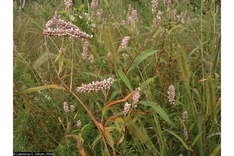
Polygonum persicaria
Ladys Thumb
Wetland Indicator: FACW
Physiographic Provinces: Appalachian Plateau, Valley and Ridge, Blue Ridge, Piedmont, Coastal Plain
Native American usage:
Decoction mixed with meal and used as a poultice for pain
Crushed leaves rubbed on poison ivy
Infusion taken for kidney stones
Decoction of leaves and flowers taken for stomach pains
Decoction of plant used as a foot and leg soak for rheumatism
Used for heart trouble
Photo credit: Stan Gilliam @ USDA-NRCS PLANTS Database
Ladys Thumb
Wetland Indicator: FACW
Physiographic Provinces: Appalachian Plateau, Valley and Ridge, Blue Ridge, Piedmont, Coastal Plain
Native American usage:
Decoction mixed with meal and used as a poultice for pain
Crushed leaves rubbed on poison ivy
Infusion taken for kidney stones
Decoction of leaves and flowers taken for stomach pains
Decoction of plant used as a foot and leg soak for rheumatism
Used for heart trouble
Photo credit: Stan Gilliam @ USDA-NRCS PLANTS Database
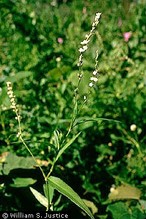
Polygonum punctatum
Dotted Smartweed
Wetland Indicator: OBL
Physiographic Provinces: Appalachian Plateau, Valley and Ridge, Blue Ridge, Piedmont, Coastal Plain
Native American usage:
Compound decoction of leaves and flowers taken for stomach pain
Decoction of roots taken for pains and swellings in the legs and joints
Photo credit: William S. Justice @ USDA-NRCS PLANTS Database
Dotted Smartweed
Wetland Indicator: OBL
Physiographic Provinces: Appalachian Plateau, Valley and Ridge, Blue Ridge, Piedmont, Coastal Plain
Native American usage:
Compound decoction of leaves and flowers taken for stomach pain
Decoction of roots taken for pains and swellings in the legs and joints
Photo credit: William S. Justice @ USDA-NRCS PLANTS Database
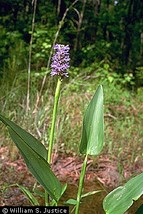
Pontederia cordata
Pickerel Weed
Wetland Indicator: OBL
Physiographic Provinces: Blue Ridge, Piedmont, Coastal Plain
Native American usage:
Infusion of plant used to prevent pregnancy
“Brew” from plant used for “illness in general”
Photo credit: William S. Justice @ USDA-NRCS PLANTS Database
Pickerel Weed
Wetland Indicator: OBL
Physiographic Provinces: Blue Ridge, Piedmont, Coastal Plain
Native American usage:
Infusion of plant used to prevent pregnancy
“Brew” from plant used for “illness in general”
Photo credit: William S. Justice @ USDA-NRCS PLANTS Database
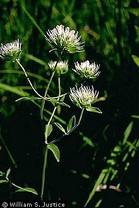
Pycnanthemum flexuosum
Narrow Leaf Mountain Mint
Wetland Indicator: FACW
Physiographic Provinces: Piedmont, Coastal Plain
Native American usage:
Poultice of leaves used for headache
Infusion taken with “green corn” to prevent diarrhea
Infusion taken for colds, fevers, upset stomach
Infusion of leaves for “heart trouble”
Photo credit: William S. Justice @ USDA-NRCS PLANTS Database
Narrow Leaf Mountain Mint
Wetland Indicator: FACW
Physiographic Provinces: Piedmont, Coastal Plain
Native American usage:
Poultice of leaves used for headache
Infusion taken with “green corn” to prevent diarrhea
Infusion taken for colds, fevers, upset stomach
Infusion of leaves for “heart trouble”
Photo credit: William S. Justice @ USDA-NRCS PLANTS Database
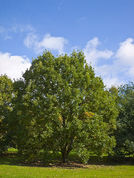
Quercus bicolor
Swamp Oak
Wetland Indicator: FACW+
Physiographic Provinces: Valley and Ridge, Blue Ridge, Piedmont, Coastal Plain
Native American usage:
Compound decoction of bark taken for cholera, for broken bones, for tuberculosis
Photo credit: Willow @ commons.wikimedia.org
Swamp Oak
Wetland Indicator: FACW+
Physiographic Provinces: Valley and Ridge, Blue Ridge, Piedmont, Coastal Plain
Native American usage:
Compound decoction of bark taken for cholera, for broken bones, for tuberculosis
Photo credit: Willow @ commons.wikimedia.org
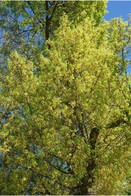
Quercus palustris
Pin Oak
Wetland Indicator: ACW
Physiographic Provinces: Valley and Ridge, Blue Ridge, Piedmont, Coastal Plain
Native American usage:
Infusion of inner bark used for intestinal pain
Photo credit: Doug Goldman @ USDA-NRCS PLANTS Database / USDA-NRCS-NPDT
Pin Oak
Wetland Indicator: ACW
Physiographic Provinces: Valley and Ridge, Blue Ridge, Piedmont, Coastal Plain
Native American usage:
Infusion of inner bark used for intestinal pain
Photo credit: Doug Goldman @ USDA-NRCS PLANTS Database / USDA-NRCS-NPDT
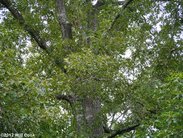
Quercus pagoda
Cherry Bark Oak
Wetland Indicator: FACW
Physiographic Provinces: not available
Native American usage:
Compound decoction of bark taken for dysentery
Decoction of root or bark applied to swollen joints, sore throat or hoarseness
Photo credit: Will Cook @ carolinanature.com
Cherry Bark Oak
Wetland Indicator: FACW
Physiographic Provinces: not available
Native American usage:
Compound decoction of bark taken for dysentery
Decoction of root or bark applied to swollen joints, sore throat or hoarseness
Photo credit: Will Cook @ carolinanature.com
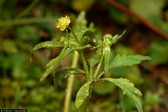
Ranunculus abortivus
Subalpine Buttercup
Wetland Indicator: FACW-
Physiographic Provinces: Appalachian Plateau, Valley and Ridge, Blue Ridge, Piedmont, Coastal Plain
Native American usage:
Poultice used for abscesses
Infusion used for “thrash”, gargled for sore throat
Juice used as a sedative
Compound decoction of roots taken for epilepsy, blood diseases, stiff muscles
Decoction of roots and leaves used as a wash for sore eyes or for snakebite
Decoction of smashed root taken for stomach trouble, to dry up smallpox
Plant used for toothache
Root used to stop nosebleed
Photo credit: Patrick J. Alexander @ USDA-NRCS PLANTS Database
Subalpine Buttercup
Wetland Indicator: FACW-
Physiographic Provinces: Appalachian Plateau, Valley and Ridge, Blue Ridge, Piedmont, Coastal Plain
Native American usage:
Poultice used for abscesses
Infusion used for “thrash”, gargled for sore throat
Juice used as a sedative
Compound decoction of roots taken for epilepsy, blood diseases, stiff muscles
Decoction of roots and leaves used as a wash for sore eyes or for snakebite
Decoction of smashed root taken for stomach trouble, to dry up smallpox
Plant used for toothache
Root used to stop nosebleed
Photo credit: Patrick J. Alexander @ USDA-NRCS PLANTS Database
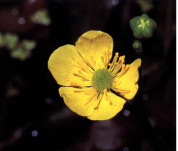
Ranunculus flabellaris
Yellow Water Buttercup
Wetland Indicator: OBL
Physiographic Provinces: Piedmont, Coastal Plain
Native American usage:
Flower stigmas used to induce sneezing for head colds
Photo credit: Robert H. Mohlenbrock @ USDA-NRCS PLANTS Database / USDA NRCS. 1992. Western wetland flora: Field office guide to plant species. West Region, Sacramento
Yellow Water Buttercup
Wetland Indicator: OBL
Physiographic Provinces: Piedmont, Coastal Plain
Native American usage:
Flower stigmas used to induce sneezing for head colds
Photo credit: Robert H. Mohlenbrock @ USDA-NRCS PLANTS Database / USDA NRCS. 1992. Western wetland flora: Field office guide to plant species. West Region, Sacramento
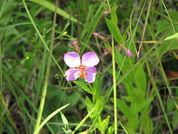
Rhexia virginica
Meadow Beauty
Wetland Indicator: OBL
Physiographic Provinces: Appalachian Plateau, Valley and Ridge, Blue Ridge, Piedmont, Coastal Plain
Native American usage:
Leaves and stems used as a throat cleanser
Photo credit: Choess @ commons.wikimedia.org
Meadow Beauty
Wetland Indicator: OBL
Physiographic Provinces: Appalachian Plateau, Valley and Ridge, Blue Ridge, Piedmont, Coastal Plain
Native American usage:
Leaves and stems used as a throat cleanser
Photo credit: Choess @ commons.wikimedia.org
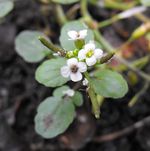
Rorippa nasturtium-aquaticum
Watercress
Wetland Indicator: OBL
Physiographic Provinces: Appalachian Plateau, Valley and Ridge, Blue Ridge, Piedmont, Coastal Plain
Native American usage:
Infusion taken for fevers
Decoction of plant used as a kidney and liver remedy, for cirrhoise of the liver and gallstones
Poultice of fresh plant applied to the forehead for headaches or for dizziness
Photo credit: public domain
Watercress
Wetland Indicator: OBL
Physiographic Provinces: Appalachian Plateau, Valley and Ridge, Blue Ridge, Piedmont, Coastal Plain
Native American usage:
Infusion taken for fevers
Decoction of plant used as a kidney and liver remedy, for cirrhoise of the liver and gallstones
Poultice of fresh plant applied to the forehead for headaches or for dizziness
Photo credit: public domain
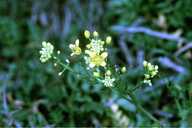
Rorippa sylvestris
Creeping Yellow Cress
Wetland Indicator: FACW
Physiographic Provinces: Valley and Ridge, Blue Ridge, Piedmont, Coastal Plain
Native American usage:
Decoction of plant taken by mother for fever in a baby
Photo credit: Robert H. Mohlenbrock @ USDA-NRCS PLANTS Database / USDA SCS. 1989. Midwest wetland flora: Field office illustrated guide to plant species. Midwest National Technical Center, Lincoln
Creeping Yellow Cress
Wetland Indicator: FACW
Physiographic Provinces: Valley and Ridge, Blue Ridge, Piedmont, Coastal Plain
Native American usage:
Decoction of plant taken by mother for fever in a baby
Photo credit: Robert H. Mohlenbrock @ USDA-NRCS PLANTS Database / USDA SCS. 1989. Midwest wetland flora: Field office illustrated guide to plant species. Midwest National Technical Center, Lincoln
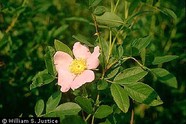
Rosa palustris
Swamp Rose
Wetland Indicator: OBL
Physiographic Provinces: Appalachian Plateau, Valley and Ridge, Blue Ridge, Piedmont, Coastal Plain
Native American usage:
Infusion of bark and root used for worms
Decoction of roots taken for dysentery
Photo credit: J.I. Jones @ USDA-NRCS PLANTS Database / USDA SCS. 1991. Southern wetland flora: Field office guide to plant species. South National
Technical Center, Fort Worth.
Swamp Rose
Wetland Indicator: OBL
Physiographic Provinces: Appalachian Plateau, Valley and Ridge, Blue Ridge, Piedmont, Coastal Plain
Native American usage:
Infusion of bark and root used for worms
Decoction of roots taken for dysentery
Photo credit: J.I. Jones @ USDA-NRCS PLANTS Database / USDA SCS. 1991. Southern wetland flora: Field office guide to plant species. South National
Technical Center, Fort Worth.
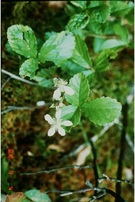
Rubus hispidus
Bristly Blackberry
Wetland Indicator: FACW
Physiographic Provinces: Appalachian Plateau, Valley and Ridge, Blue Ridge, Piedmont, Coastal Plain
Native American usage:
Roots used for cough, fever, tuberculosis
Infusion of berries used to treat worms
Juice of plant or berry taken for dysentery
Infusion taken for diarrhea
Infusion of leaves taken for boils
Photo credit: J.I. Jones @ USDA-NRCS PLANTS Database / USDA SCS. 1991. Southern wetland flora: Field office guide to plant species. South National Technical Center, Fort Worth.
Bristly Blackberry
Wetland Indicator: FACW
Physiographic Provinces: Appalachian Plateau, Valley and Ridge, Blue Ridge, Piedmont, Coastal Plain
Native American usage:
Roots used for cough, fever, tuberculosis
Infusion of berries used to treat worms
Juice of plant or berry taken for dysentery
Infusion taken for diarrhea
Infusion of leaves taken for boils
Photo credit: J.I. Jones @ USDA-NRCS PLANTS Database / USDA SCS. 1991. Southern wetland flora: Field office guide to plant species. South National Technical Center, Fort Worth.
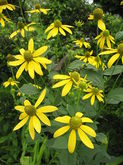
Rudbeckia laciniata
Cut Leaf Coneflower
Wetland Indicator: FACW
Physiographic Provinces: Appalachian Plateau, Valley and Ridge, Blue Ridge, Piedmont, Coastal Plain
Native American usage:
Cooked spring salad used as a general health aid
Compound poultice of blossoms applied to burn
Compound infusion of roots taken for indigestion
Photo credit: GFDL @ commons.wikimedia.org
Cut Leaf Coneflower
Wetland Indicator: FACW
Physiographic Provinces: Appalachian Plateau, Valley and Ridge, Blue Ridge, Piedmont, Coastal Plain
Native American usage:
Cooked spring salad used as a general health aid
Compound poultice of blossoms applied to burn
Compound infusion of roots taken for indigestion
Photo credit: GFDL @ commons.wikimedia.org
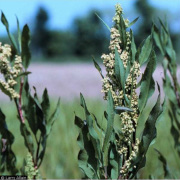
Rumex verticillatus
Swamp Dock
Wetland Indicator: OBL
Physiographic Provinces: Valley and Ridge, Blue Ridge, Piedmont, Coastal Plain
Native American usage:
Decoction or infusion of leaves used in a bath to prevent smallpox
Photo credit: Larry Allain @ USDA-NRCS PLANTS Database
Swamp Dock
Wetland Indicator: OBL
Physiographic Provinces: Valley and Ridge, Blue Ridge, Piedmont, Coastal Plain
Native American usage:
Decoction or infusion of leaves used in a bath to prevent smallpox
Photo credit: Larry Allain @ USDA-NRCS PLANTS Database
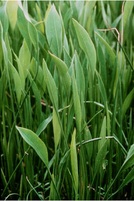
Sagittaria lancifolia ssp media
Bultonongue
Wetland Indicator: OBL
Physiographic Provinces: Piedmont, Coastal Plain
Native American usage:
Used for alligator bites
Photo credit: George Folkerts @ USDA-NRCS PLANTS Database / USDA SCS. 1991. Southern wetland flora: Field office guide to plant species. South National Technical Center, Fort Worth.
Bultonongue
Wetland Indicator: OBL
Physiographic Provinces: Piedmont, Coastal Plain
Native American usage:
Used for alligator bites
Photo credit: George Folkerts @ USDA-NRCS PLANTS Database / USDA SCS. 1991. Southern wetland flora: Field office guide to plant species. South National Technical Center, Fort Worth.
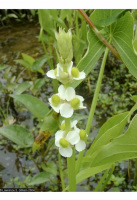
Sagittaria latifolia
Duck Potato
Wetland Indicator: OBL
Physiographic Provinces: Appalachian Plateau, Valley and Ridge, Blue Ridge, Piedmont, Coastal Plain
Native American usage:
Infusion of leaves, one sip given to children and then remainder used to bath feverish baby
Infusion of root taken for indigestion
Infusion of plant taken for rheumatism
Poultice of corm pounded and applied to wounds and sores
Compound decoction taken for constipation
Photo credit: Stan Gilliam @ USDA-NRCS PLANTS Database
Duck Potato
Wetland Indicator: OBL
Physiographic Provinces: Appalachian Plateau, Valley and Ridge, Blue Ridge, Piedmont, Coastal Plain
Native American usage:
Infusion of leaves, one sip given to children and then remainder used to bath feverish baby
Infusion of root taken for indigestion
Infusion of plant taken for rheumatism
Poultice of corm pounded and applied to wounds and sores
Compound decoction taken for constipation
Photo credit: Stan Gilliam @ USDA-NRCS PLANTS Database
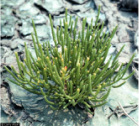
Salicornia virginica
Virginia Glasswort
Wetland Indicator: OBL
Physiographic Provinces: Coastal Plain
Native American usage:
Plant used for arthritic pain, rheumatism, aches, pain and swelling
Photo credit: Larry Allain @ USDA-NRCS PLANTS Database
Virginia Glasswort
Wetland Indicator: OBL
Physiographic Provinces: Coastal Plain
Native American usage:
Plant used for arthritic pain, rheumatism, aches, pain and swelling
Photo credit: Larry Allain @ USDA-NRCS PLANTS Database
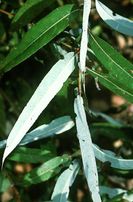
Salix caroliniana
Coastal Plain Willow
Wetland Indicator: OBL
Physiographic Provinces: Appalachian Plateau, Valley and Ridge, Blue Ridge, Piedmont, Coastal Plain
Native American usage:
Decoction of roots and bark taken for “feebleness” due to “thin blood” and for fever
Infusion of bark used to induce vomiting in the case of “rainbow sickness”: fever, stiff neck and backache
Infusion of bark taken for “thunder sickness”: fever, dizziness, headache and diarrhea
Plant used for “fire sickness”: fever and body aches
Cold infusion of plant used for bath for body aches
Decoction of bark taken for “menstruation sickness”: yellow eyes and skin, weakness, and shaking head
Infusion of inner bark used for “mist sickness”: eye disease, fever, chills
Photo credit: public domain
Coastal Plain Willow
Wetland Indicator: OBL
Physiographic Provinces: Appalachian Plateau, Valley and Ridge, Blue Ridge, Piedmont, Coastal Plain
Native American usage:
Decoction of roots and bark taken for “feebleness” due to “thin blood” and for fever
Infusion of bark used to induce vomiting in the case of “rainbow sickness”: fever, stiff neck and backache
Infusion of bark taken for “thunder sickness”: fever, dizziness, headache and diarrhea
Plant used for “fire sickness”: fever and body aches
Cold infusion of plant used for bath for body aches
Decoction of bark taken for “menstruation sickness”: yellow eyes and skin, weakness, and shaking head
Infusion of inner bark used for “mist sickness”: eye disease, fever, chills
Photo credit: public domain
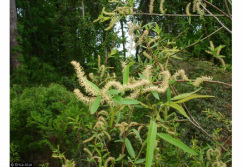
Salix nigra
Black Willow
Wetland Indicator: FACW+
Physiographic Provinces: Appalachian Plateau, Valley and Ridge, Blue Ridge, Piedmont, Coastal Plain
Native American usage:
Infusion of bark taken to help bowels
Bark used as a poultice and as a tonic
Decoction of roots and bark or an Infusion taken for fever
Infusion of roots taken for fevers and for headaches
Compound decoction taken for coughs and for stomach gas
Used for mouth and throat abscesses
Poultice of bruised leaves used on sprains and bruises
Poultice of scraped root and spirits applied to sprains and broken bones
Photo credit: Erica Asai @ USDA-NRCS PLANTS Database
Black Willow
Wetland Indicator: FACW+
Physiographic Provinces: Appalachian Plateau, Valley and Ridge, Blue Ridge, Piedmont, Coastal Plain
Native American usage:
Infusion of bark taken to help bowels
Bark used as a poultice and as a tonic
Decoction of roots and bark or an Infusion taken for fever
Infusion of roots taken for fevers and for headaches
Compound decoction taken for coughs and for stomach gas
Used for mouth and throat abscesses
Poultice of bruised leaves used on sprains and bruises
Poultice of scraped root and spirits applied to sprains and broken bones
Photo credit: Erica Asai @ USDA-NRCS PLANTS Database
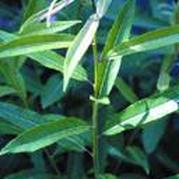
Salix sericea
Silky Willow
Wetland Indicator: OBL
Physiographic Provinces: Appalachian Plateau, Valley and Ridge, Blue Ridge, Piedmont, Coastal Plain
Native American usage:
Used for mouth and throat abscesses
Photo credit: US Fish and Wildlife Service Native Plant Center
Silky Willow
Wetland Indicator: OBL
Physiographic Provinces: Appalachian Plateau, Valley and Ridge, Blue Ridge, Piedmont, Coastal Plain
Native American usage:
Used for mouth and throat abscesses
Photo credit: US Fish and Wildlife Service Native Plant Center
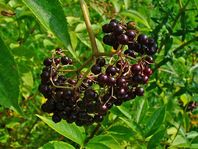
Sambucus canadensis
Common Elderberry
Wetland Indicator: FACW-
Physiographic Provinces: Appalachian Plateau, Valley and Ridge, Blue Ridge, Piedmont, Coastal Plain
Native American usage:
Infusion of bark used to induce vomiting and as a laxative
Infusion of berries used for rheumatism
Salve used for burns, as a cathartic, used for skin eruptions
Infusion of branches applied to head for severe headaches
Leaves used to wash sores to prevent infection, poultice of barks scraping applied to sores, swellings and wounds
Decoction of seeds and roots taken for liver trouble
Pounded root or stalk poultice applied to breast to reduce swelling
Leaves and stems used for jaundice
Infusion of flowers given to infants for colic
Infusion of bark taken for measles, compound decoction of plant taken for diphtheria
Infusion of berries taken and poultice applied to swellings caused by mumps
Inner bark of young shoots used as a diuretic
Fresh bark used in hollow tooth for toothache
Photo credit: H Zell @ commons.wikimedia.org
Common Elderberry
Wetland Indicator: FACW-
Physiographic Provinces: Appalachian Plateau, Valley and Ridge, Blue Ridge, Piedmont, Coastal Plain
Native American usage:
Infusion of bark used to induce vomiting and as a laxative
Infusion of berries used for rheumatism
Salve used for burns, as a cathartic, used for skin eruptions
Infusion of branches applied to head for severe headaches
Leaves used to wash sores to prevent infection, poultice of barks scraping applied to sores, swellings and wounds
Decoction of seeds and roots taken for liver trouble
Pounded root or stalk poultice applied to breast to reduce swelling
Leaves and stems used for jaundice
Infusion of flowers given to infants for colic
Infusion of bark taken for measles, compound decoction of plant taken for diphtheria
Infusion of berries taken and poultice applied to swellings caused by mumps
Inner bark of young shoots used as a diuretic
Fresh bark used in hollow tooth for toothache
Photo credit: H Zell @ commons.wikimedia.org
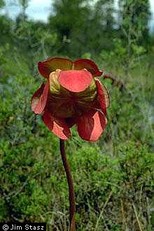
Sarracenia purpurea
Northern Pitcher Plant
Wetland Indicator: OBL
Physiographic Provinces: Piedmont, Coastal Plain
Native American usage:
Infusion of leaves used to ease childbirth, decoction of root used to ease sickness after childbirth
Decoction of root used to expel afterbirth
Decoction of root tips taken for urinary difficulties, roots used as a diuretic
Decoction taken for lower back pain, for venereal disease
Compound decoction of leaves taken for recurring chills followed by fever
Infusion of dried leaves used for high fever and shakiness
Compound infusion of whole roots taken for liver sickness, decoction taken for pulmonary complaints
Cold decoction of whole plant taken for whooping cough, plant also used for pneumonia
Infusion of plant used to treat tuberculosis
Roots and infusion of leaves used for smallpox
Photo credit: Jim Stasz @ USDA-NRCS PLANTS Database
Northern Pitcher Plant
Wetland Indicator: OBL
Physiographic Provinces: Piedmont, Coastal Plain
Native American usage:
Infusion of leaves used to ease childbirth, decoction of root used to ease sickness after childbirth
Decoction of root used to expel afterbirth
Decoction of root tips taken for urinary difficulties, roots used as a diuretic
Decoction taken for lower back pain, for venereal disease
Compound decoction of leaves taken for recurring chills followed by fever
Infusion of dried leaves used for high fever and shakiness
Compound infusion of whole roots taken for liver sickness, decoction taken for pulmonary complaints
Cold decoction of whole plant taken for whooping cough, plant also used for pneumonia
Infusion of plant used to treat tuberculosis
Roots and infusion of leaves used for smallpox
Photo credit: Jim Stasz @ USDA-NRCS PLANTS Database
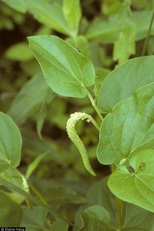
Saururus cernuus
Lizard’s Tail
Wetland Indicator: OBL
Physiographic Provinces: Appalachian Plateau, Valley and Ridge, Blue Ridge, Piedmont, Coastal Plain
Native American usage:
Roots roasted and mashed and used as a poultice for wounds
Infusion of pounded plants used for rheumatism and for general illness
Infusion of plant used for stomach troubles
Photo credit: Elaine Haug @ USDA-NRCS PLANTS Database
Lizard’s Tail
Wetland Indicator: OBL
Physiographic Provinces: Appalachian Plateau, Valley and Ridge, Blue Ridge, Piedmont, Coastal Plain
Native American usage:
Roots roasted and mashed and used as a poultice for wounds
Infusion of pounded plants used for rheumatism and for general illness
Infusion of plant used for stomach troubles
Photo credit: Elaine Haug @ USDA-NRCS PLANTS Database
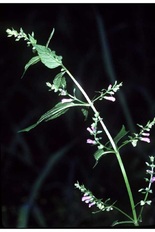
Scutellaria lateriflora
Blue Skullcap
Wetland Indicator: FACW+
Physiographic Provinces: Appalachian Plateau, Valley and Ridge, Blue Ridge, Piedmont, Coastal Plain
Native American usage:
Infusion of roots used for monthly periods, compound used for breast pain,
Compound or decoction of roots used to help expel afterbirth
Infusion of powdered roots taken to prevent smallpox, to keep the throat clean
Root compound used as kidney medicine
Infusion of root taken for diarrhea
Photo credit: Robert H. Mohlenbrock @ USDA-NRCS PLANTS Database / USDA SCS. 1989. Midwest wetland flora: Field office illustrated guide to plant species. Midwest National Technical Center, Lincoln.
Blue Skullcap
Wetland Indicator: FACW+
Physiographic Provinces: Appalachian Plateau, Valley and Ridge, Blue Ridge, Piedmont, Coastal Plain
Native American usage:
Infusion of roots used for monthly periods, compound used for breast pain,
Compound or decoction of roots used to help expel afterbirth
Infusion of powdered roots taken to prevent smallpox, to keep the throat clean
Root compound used as kidney medicine
Infusion of root taken for diarrhea
Photo credit: Robert H. Mohlenbrock @ USDA-NRCS PLANTS Database / USDA SCS. 1989. Midwest wetland flora: Field office illustrated guide to plant species. Midwest National Technical Center, Lincoln.
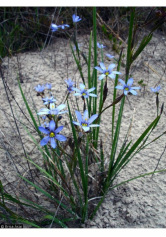
Sisyrinchium angustifolium
Pointed Blue Eyed Grass
Wetland Indicator: FACW-
Physiographic Provinces: Appalachian Plateau, Valley and Ridge, Blue Ridge, Piedmont, Coastal Plain
Native American usage:
Infusion of root given to children for diarrhea
Eaten as cooked greens to promote regularity and decoction taken to prevent constipation
Infusion taken for stomach worms and other stomach troubles
Photo credit: Erica Asai @ USDA-NRCS PLANTS Database
Pointed Blue Eyed Grass
Wetland Indicator: FACW-
Physiographic Provinces: Appalachian Plateau, Valley and Ridge, Blue Ridge, Piedmont, Coastal Plain
Native American usage:
Infusion of root given to children for diarrhea
Eaten as cooked greens to promote regularity and decoction taken to prevent constipation
Infusion taken for stomach worms and other stomach troubles
Photo credit: Erica Asai @ USDA-NRCS PLANTS Database
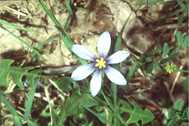
Sisyrinchium atlanticum
Eastern Blue Eyed Grass
Wetland Indicator: FACW
Physiographic Provinces: Valley and Ridge, Blue Ridge, Piedmont, Coastal Plain
Native American usage:
Compound decoction of plant taken to help expel afterbirth
Photo credit: Robert H. Mohlenbrock @ USDA-NRCS PLANTS Database / USDA SCS. 1991. Southern wetland flora: Field office guide to plant species. South National Technical Center, Fort Worth.
Eastern Blue Eyed Grass
Wetland Indicator: FACW
Physiographic Provinces: Valley and Ridge, Blue Ridge, Piedmont, Coastal Plain
Native American usage:
Compound decoction of plant taken to help expel afterbirth
Photo credit: Robert H. Mohlenbrock @ USDA-NRCS PLANTS Database / USDA SCS. 1991. Southern wetland flora: Field office guide to plant species. South National Technical Center, Fort Worth.
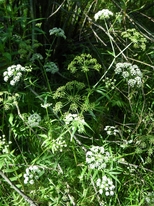
Sium Suave
Hemlock Water Parsnip
Wetland Indicator: OBL
Physiographic Provinces: Valley and Ridge, Blue Ridge, Piedmont, Coastal Plain
Native American usage:
Roots smashed and applied as a poultice for pain from broken limbs
Roots used for the stomach
Compound decoction of roots taken by women for epilepsy
Photo credit: University of Michigan Herbarium
Hemlock Water Parsnip
Wetland Indicator: OBL
Physiographic Provinces: Valley and Ridge, Blue Ridge, Piedmont, Coastal Plain
Native American usage:
Roots smashed and applied as a poultice for pain from broken limbs
Roots used for the stomach
Compound decoction of roots taken by women for epilepsy
Photo credit: University of Michigan Herbarium
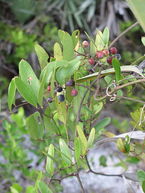
Smilax laurifolia
Laurel Leaf Greenbrier
Wetland Indicator: OBL
Physiographic Provinces: Piedmont, Coastal Plain
Native American usage:
Compound of root bark used as a wash for burns and sores
Decoction of root taken for urinary problems
Photo credit: scott.zona @ commons.wikimedia.org
Laurel Leaf Greenbrier
Wetland Indicator: OBL
Physiographic Provinces: Piedmont, Coastal Plain
Native American usage:
Compound of root bark used as a wash for burns and sores
Decoction of root taken for urinary problems
Photo credit: scott.zona @ commons.wikimedia.org
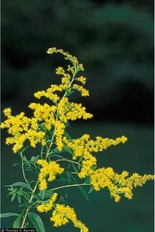
Solidago gigantea
Giant Goldenrod
Wetland Indicator: FACW
Physiographic Provinces: Appalachian Plateau, Valley and Ridge, Blue Ridge, Piedmont, Coastal Plain
Native American usage:
Infusion of leaves used as a tonic
Infusion of blooms used for fevers
Photo credit: Thomas G. Barnes @ USDA-NRCS PLANTS Database / Barnes, T.G., and S.W. Francis. 2004. Wildflowers and ferns of Kentucky. University Press of Kentucky.
Giant Goldenrod
Wetland Indicator: FACW
Physiographic Provinces: Appalachian Plateau, Valley and Ridge, Blue Ridge, Piedmont, Coastal Plain
Native American usage:
Infusion of leaves used as a tonic
Infusion of blooms used for fevers
Photo credit: Thomas G. Barnes @ USDA-NRCS PLANTS Database / Barnes, T.G., and S.W. Francis. 2004. Wildflowers and ferns of Kentucky. University Press of Kentucky.
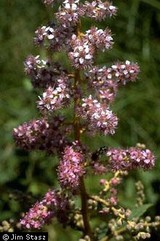
Spiraea tomentosa
Steeple Bush
Wetland Indicator: FACW
Physiographic Provinces: Appalachian Plateau, Valley and Ridge, Blue Ridge, Piedmont, Coastal Plain
Native American usage:
Infusion of leaves and stems used as a medicinal tea
Infusion of leaves taken for dysentery
Infusion of leaves and flowers taken to prevent morning sickness and used to ease childbirth
Photo credit: Jim Stasz @ USDA-NRCS PLANTS Database
Steeple Bush
Wetland Indicator: FACW
Physiographic Provinces: Appalachian Plateau, Valley and Ridge, Blue Ridge, Piedmont, Coastal Plain
Native American usage:
Infusion of leaves and stems used as a medicinal tea
Infusion of leaves taken for dysentery
Infusion of leaves and flowers taken to prevent morning sickness and used to ease childbirth
Photo credit: Jim Stasz @ USDA-NRCS PLANTS Database
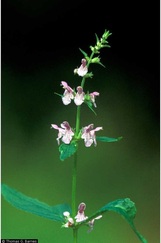
Stachys tenuifolia
Common Hedge Nettle
Wetland Indicator: FACW+
Physiographic Provinces: Appalachian Plateau, Valley and Ridge, Blue Ridge, Piedmont, Coastal Plain
Native American usage:
Infusion of leaves taken for colds and given to induce vomiting
Photo credit: Thomas G. Barnes @ USDA-NRCS PLANTS Database / Barnes, T.G., and S.W. Francis. 2004. Wildflowers and ferns of Kentucky. University Press of Kentucky.
Common Hedge Nettle
Wetland Indicator: FACW+
Physiographic Provinces: Appalachian Plateau, Valley and Ridge, Blue Ridge, Piedmont, Coastal Plain
Native American usage:
Infusion of leaves taken for colds and given to induce vomiting
Photo credit: Thomas G. Barnes @ USDA-NRCS PLANTS Database / Barnes, T.G., and S.W. Francis. 2004. Wildflowers and ferns of Kentucky. University Press of Kentucky.
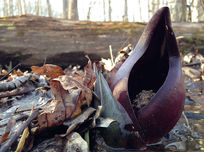
Symplocarpus foetidus
Skunk Cabbage
Wetland Indicator: OBL
Physiographic Provinces: Valley and Ridge, Blue Ridge, Piedmont, Coastal Plain
Native American usage:
Infusion of roots or leaves taken as a cough medicine and for whooping cough
Small portions of raw leaves eaten for seizures, compound infusion used for convulsions
Poultice of leaf bases applied to swellings, poultice of dried root applied to wounds
Root hairs used for toothaches, hemorrhages
Decoction of root used for “weak heart”, infusion of powdered root taken for tuberculosis
Seeds used as medicine but the reason was unspecified in the reference material
Given to children for worms
Photo credit: Fritzflohrreynolds @ commons.wikimedia.org
Skunk Cabbage
Wetland Indicator: OBL
Physiographic Provinces: Valley and Ridge, Blue Ridge, Piedmont, Coastal Plain
Native American usage:
Infusion of roots or leaves taken as a cough medicine and for whooping cough
Small portions of raw leaves eaten for seizures, compound infusion used for convulsions
Poultice of leaf bases applied to swellings, poultice of dried root applied to wounds
Root hairs used for toothaches, hemorrhages
Decoction of root used for “weak heart”, infusion of powdered root taken for tuberculosis
Seeds used as medicine but the reason was unspecified in the reference material
Given to children for worms
Photo credit: Fritzflohrreynolds @ commons.wikimedia.org
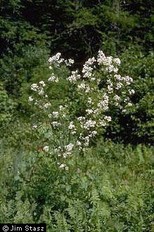
Thalictrum pubescens
Tall Meadow Rue
Wetland Indicator: FACW+
Physiographic Provinces: Appalachian Plateau, Valley and Ridge, Blue Ridge, Piedmont, Coastal Plain
Native American usage:
Infusion of smashed plant used to wash head and neck for nosebleed
Compound infusion of roots taken as a medicine for the liver
Photo credit: Fritzflohrreynolds @ commons.wikimedia.org
Tall Meadow Rue
Wetland Indicator: FACW+
Physiographic Provinces: Appalachian Plateau, Valley and Ridge, Blue Ridge, Piedmont, Coastal Plain
Native American usage:
Infusion of smashed plant used to wash head and neck for nosebleed
Compound infusion of roots taken as a medicine for the liver
Photo credit: Fritzflohrreynolds @ commons.wikimedia.org
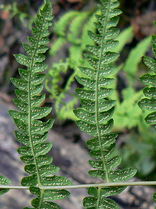
Thelypsteris palustris
Marsh Fern
Wetland Indicator: FACW+
Physiographic Provinces: Valley and Ridge, Blue Ridge, Piedmont, Coastal Plain
Native American usage:
Roots used for “women’s trouble”
Photo credit: Johan N @ commons.wikimedia.org
Marsh Fern
Wetland Indicator: FACW+
Physiographic Provinces: Valley and Ridge, Blue Ridge, Piedmont, Coastal Plain
Native American usage:
Roots used for “women’s trouble”
Photo credit: Johan N @ commons.wikimedia.org
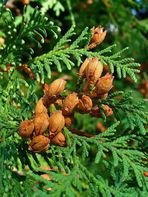
Thuja occidentalis
Northern White Cedar
Wetland Indicator: FACW
Physiographic Provinces: Valley and Ridge, Blue Ridge, Piedmont
Native American usage:
Poultice of powdered leaves applied to swellings
Poultice of rotten wood used for rashes and skin irritations
Decoction of branches taken for rheumatism, for toothache, for pneumonia and for sore bladder
Branches used in steam baths for colds, fevers, rheumatism and for women after childbirth
Infusion of cones used for babies with colic
Infusion of plant taken for menstrual disorders
Compound of leaves taken as a cough syrup
Decoction used as a wash or poultice for cuts, bruises or sores
Bark, inner bark and stems used for burns, coughs and tuberculosis
Photo credit: H Zell @ commons.wikimedia.org
Northern White Cedar
Wetland Indicator: FACW
Physiographic Provinces: Valley and Ridge, Blue Ridge, Piedmont
Native American usage:
Poultice of powdered leaves applied to swellings
Poultice of rotten wood used for rashes and skin irritations
Decoction of branches taken for rheumatism, for toothache, for pneumonia and for sore bladder
Branches used in steam baths for colds, fevers, rheumatism and for women after childbirth
Infusion of cones used for babies with colic
Infusion of plant taken for menstrual disorders
Compound of leaves taken as a cough syrup
Decoction used as a wash or poultice for cuts, bruises or sores
Bark, inner bark and stems used for burns, coughs and tuberculosis
Photo credit: H Zell @ commons.wikimedia.org
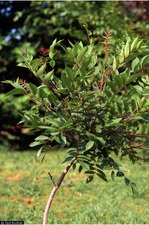
Toxicodendron vernix
Poison Sumac
Wetland Indicator: OBL
Physiographic Provinces: Valley and Ridge, Blue Ridge, Piedmont, Coastal Plain
Native American usage:
Plant considered poisonous but still used as a wash for external ulcers and for fever, malaria, asthma, and chlamydia
Photo credit: Ted Bodner @ USDA-NRCS PLANTS Database / James H. Miller and Karl V. Miller. 2005. Forest plants of the southeast and their wildlife uses. University of Georgia Press., Athens.
Poison Sumac
Wetland Indicator: OBL
Physiographic Provinces: Valley and Ridge, Blue Ridge, Piedmont, Coastal Plain
Native American usage:
Plant considered poisonous but still used as a wash for external ulcers and for fever, malaria, asthma, and chlamydia
Photo credit: Ted Bodner @ USDA-NRCS PLANTS Database / James H. Miller and Karl V. Miller. 2005. Forest plants of the southeast and their wildlife uses. University of Georgia Press., Athens.
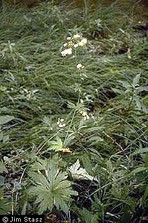
Trauvetteria caroliniensis
Carolina Tassel Rue
Wetland Indicator: FACW-
Physiographic Provinces: Appalachian Plateau, Valley and Ridge, Blue Ridge, Piedmont, Coastal Plain
Native American usage:
Roots pounded, made into a poultice and applied to boils
Photo credit: Jim Stasz @ USDA-NRCS PLANTS Database
Carolina Tassel Rue
Wetland Indicator: FACW-
Physiographic Provinces: Appalachian Plateau, Valley and Ridge, Blue Ridge, Piedmont, Coastal Plain
Native American usage:
Roots pounded, made into a poultice and applied to boils
Photo credit: Jim Stasz @ USDA-NRCS PLANTS Database
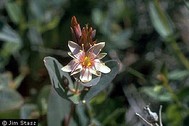
Triadenum virginicum
Marsh St. Johns Wort
Wetland Indicator: OBL
Physiographic Provinces: Valley and Ridge, Blue Ridge, Piedmont, Coastal Plain
Native American usage:
Infusion of leaves used for fevers
Photo credit: Jim Stasz @ USDA-NRCS PLANTS Database
Marsh St. Johns Wort
Wetland Indicator: OBL
Physiographic Provinces: Valley and Ridge, Blue Ridge, Piedmont, Coastal Plain
Native American usage:
Infusion of leaves used for fevers
Photo credit: Jim Stasz @ USDA-NRCS PLANTS Database
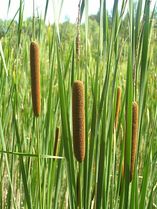
Typha angustifolia
Narrow Leaf Cattail
Wetland Indicator: OBL
Physiographic Provinces: Appalachian Plateau, Valley and Ridge, Blue Ridge, Piedmont, Coastal Plain
Native American usage:
Infusion of root used for kidney stones
Photo credit: Petr Filippov @ commons.wikimedia.org
Narrow Leaf Cattail
Wetland Indicator: OBL
Physiographic Provinces: Appalachian Plateau, Valley and Ridge, Blue Ridge, Piedmont, Coastal Plain
Native American usage:
Infusion of root used for kidney stones
Photo credit: Petr Filippov @ commons.wikimedia.org
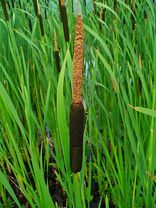
Typha latifolia
Broad Leaf Cattail
Wetland Indicator: OBL
Physiographic Provinces: Appalachian Plateau, Valley and Ridge, Blue Ridge, Piedmont, Coastal Plain
Native American usage:
Roots crushed and made into a poultice for wounds, infections an sprains
Pollen used as medicine but for unspecified purposes
Infusion of roots and leaf base taken for abdominal cramps
Down used as a dressing for burns and scalds and to prevent chafing with infants
Roots used to dissolve kidney stones, gonorrhea
Decoction of stalks taken for whooping cough
Greased leaves used for sores
Young flowering heads eaten for diarrhea
Photo credit: H Zell @ commons.wikimedia.org
Broad Leaf Cattail
Wetland Indicator: OBL
Physiographic Provinces: Appalachian Plateau, Valley and Ridge, Blue Ridge, Piedmont, Coastal Plain
Native American usage:
Roots crushed and made into a poultice for wounds, infections an sprains
Pollen used as medicine but for unspecified purposes
Infusion of roots and leaf base taken for abdominal cramps
Down used as a dressing for burns and scalds and to prevent chafing with infants
Roots used to dissolve kidney stones, gonorrhea
Decoction of stalks taken for whooping cough
Greased leaves used for sores
Young flowering heads eaten for diarrhea
Photo credit: H Zell @ commons.wikimedia.org
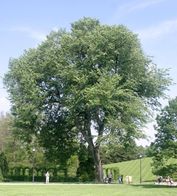
Ulmus americana
American Elm
Wetland Indicator: FACW-
Physiographic Provinces: Appalachian Plateau, Valley and Ridge, Blue Ridge, Piedmont, Coastal Plain
Native American usage:
Infusion or decoction of bark taken to ensure stable pregnancy and for menstrual cramps
Infusion of inner bark used for coughs and colds and pulmonary hemorrhage
Compound decoction of bark taken for dysentery and for broken bone
Infusion of root taken for gonorrhea
Decoction of root bark applied to sore eyes as a lotion
Compound decoction with smashed twigs taken for internal hemorrhage
Bark used to treat diarrhea
Photo credit: Henryhartley @ commons.wikimedia.org
American Elm
Wetland Indicator: FACW-
Physiographic Provinces: Appalachian Plateau, Valley and Ridge, Blue Ridge, Piedmont, Coastal Plain
Native American usage:
Infusion or decoction of bark taken to ensure stable pregnancy and for menstrual cramps
Infusion of inner bark used for coughs and colds and pulmonary hemorrhage
Compound decoction of bark taken for dysentery and for broken bone
Infusion of root taken for gonorrhea
Decoction of root bark applied to sore eyes as a lotion
Compound decoction with smashed twigs taken for internal hemorrhage
Bark used to treat diarrhea
Photo credit: Henryhartley @ commons.wikimedia.org
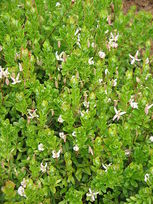
Vaccinum macrocarpon
Large Cranberry
Wetland Indicator: OBL
Physiographic Provinces: Valley and Ridge, Blue Ridge, Piedmont
Native American usage:
Infusion of branches used as a medicine for pleurisy
Photo credit: Meneerke bloem @ commons.wikimedia.org
Large Cranberry
Wetland Indicator: OBL
Physiographic Provinces: Valley and Ridge, Blue Ridge, Piedmont
Native American usage:
Infusion of branches used as a medicine for pleurisy
Photo credit: Meneerke bloem @ commons.wikimedia.org
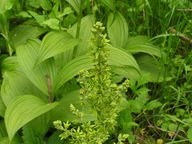
Veratrum viride
American False Hellebore
Wetland Indicator: FACW+
Physiographic Provinces: Valley and Ridge, Blue Ridge, Piedmont, Coastal Plain
Native American usage:
Decoction of bulb taken for stomachache, chronic cough, constipation, gonorrhea
Compound of bulb made into a poultice and applied to skin fo rheumatism, also applied to chest for heart trouble
Roots used for skin washes and as a compress for bruises, sprains and fractures,
Compound used as a liniment for sore muscles
Roots used to induce vomiting and as a sedative
Stems scraped and powder used to induce sneezing, roots also dried for the same reason
Infusion of leaves used as a wash for aches and pains
Dried root used to treat tuberculosis
Some groups considered the plant poisonous; roots were ingested to commit suicide
Juice used to induce abortion
Photo credit: User:SB_Johnny @ commons.wikimedia.org
American False Hellebore
Wetland Indicator: FACW+
Physiographic Provinces: Valley and Ridge, Blue Ridge, Piedmont, Coastal Plain
Native American usage:
Decoction of bulb taken for stomachache, chronic cough, constipation, gonorrhea
Compound of bulb made into a poultice and applied to skin fo rheumatism, also applied to chest for heart trouble
Roots used for skin washes and as a compress for bruises, sprains and fractures,
Compound used as a liniment for sore muscles
Roots used to induce vomiting and as a sedative
Stems scraped and powder used to induce sneezing, roots also dried for the same reason
Infusion of leaves used as a wash for aches and pains
Dried root used to treat tuberculosis
Some groups considered the plant poisonous; roots were ingested to commit suicide
Juice used to induce abortion
Photo credit: User:SB_Johnny @ commons.wikimedia.org
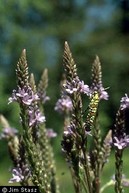
Verbena hastata
Blue Vervain
Wetland Indicator: FACW+
Physiographic Provinces: Valley and Ridge, Blue Ridge, Piedmont, Coastal Plain
Native American usage:
Leaves, seeds and roots used to treat early fever and to induce vomiting
Used for “female obstructions” and for breast pain
Compound taken for bowel complaints and dysentery, decoction of leaves taken for stomachache
Dried flowers taken for nose bleed
Compound decoction of roots taken for worms and stomach cramps
Taken for colds and coughs, compound infusion of root taken for earaches
Photo credit: Jim Stasz @ USDA-NRCS PLANTS Database
Blue Vervain
Wetland Indicator: FACW+
Physiographic Provinces: Valley and Ridge, Blue Ridge, Piedmont, Coastal Plain
Native American usage:
Leaves, seeds and roots used to treat early fever and to induce vomiting
Used for “female obstructions” and for breast pain
Compound taken for bowel complaints and dysentery, decoction of leaves taken for stomachache
Dried flowers taken for nose bleed
Compound decoction of roots taken for worms and stomach cramps
Taken for colds and coughs, compound infusion of root taken for earaches
Photo credit: Jim Stasz @ USDA-NRCS PLANTS Database
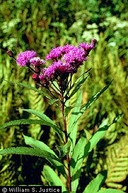
Vernonia noveboracensis
New York Ironweed
Wetland Indicator: FACW+
Physiographic Provinces: Appalachian Plateau, Valley and Ridge, Blue Ridge, Piedmont, Coastal Plain
Native American usage:
Infusion of root given for pain after childbirth, various infusions given for “monthly period” and to “prevent menstruation”
Infusion of root used for loose teeth and for stomach ulcers and hemorrhage
Photo credit: William S. Justice @ USDA-NRCS PLANTS Database
New York Ironweed
Wetland Indicator: FACW+
Physiographic Provinces: Appalachian Plateau, Valley and Ridge, Blue Ridge, Piedmont, Coastal Plain
Native American usage:
Infusion of root given for pain after childbirth, various infusions given for “monthly period” and to “prevent menstruation”
Infusion of root used for loose teeth and for stomach ulcers and hemorrhage
Photo credit: William S. Justice @ USDA-NRCS PLANTS Database
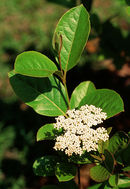
Viburnum nudum var. cassinoides
Possomhaw
Wetland Indicator: FACW
Physiographic Provinces: Appalachian Plateau, Valley and Ridge, Blue Ridge, Piedmont
Native American usage:
Infusion taken to prevent recurrent spasms
Root bark taken to induce sweating and as a general tonic
Compound infusion taken for fever, smallpox, and malaria
Infusion of bark used as a wash for sore tongue
Photo credit: Ted Bodner, James H Miller @ commons.wikimedia.org
Possomhaw
Wetland Indicator: FACW
Physiographic Provinces: Appalachian Plateau, Valley and Ridge, Blue Ridge, Piedmont
Native American usage:
Infusion taken to prevent recurrent spasms
Root bark taken to induce sweating and as a general tonic
Compound infusion taken for fever, smallpox, and malaria
Infusion of bark used as a wash for sore tongue
Photo credit: Ted Bodner, James H Miller @ commons.wikimedia.org
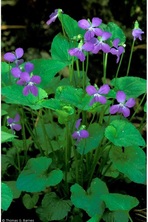
Viola cucullata
Marsh Blue Violet
Wetland Indicator: FACW+
Physiographic Provinces: Unknown
Native American usage:
Poultice of leaves used for headache
Infusion taken for dysentery, for the blood, for colds and coughs and as a spring tonic
Poultice of crushed root applied to boils
Infusion sprayed on nose for catarrh
Photo credit: Thomas G. Barnes @ USDA-NRCS PLANTS Database / Barnes, T.G., and S.W. Francis. 2004. Wildflowers and ferns of Kentucky. University Press of Kentucky.
Marsh Blue Violet
Wetland Indicator: FACW+
Physiographic Provinces: Unknown
Native American usage:
Poultice of leaves used for headache
Infusion taken for dysentery, for the blood, for colds and coughs and as a spring tonic
Poultice of crushed root applied to boils
Infusion sprayed on nose for catarrh
Photo credit: Thomas G. Barnes @ USDA-NRCS PLANTS Database / Barnes, T.G., and S.W. Francis. 2004. Wildflowers and ferns of Kentucky. University Press of Kentucky.
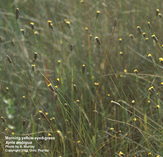
Xyris ambigua
Coastal Plain Yellow Eyed Grass
Wetland Indicator: OBL
Physiographic Provinces: Valley and Ridge, Blue Ridge, Piedmont, Coastal Plain
Native American usage:
Infusion of herbage rubbed on chest for colds and for pulmonary disorders
Photo credit: A. Murray University of Florida
Coastal Plain Yellow Eyed Grass
Wetland Indicator: OBL
Physiographic Provinces: Valley and Ridge, Blue Ridge, Piedmont, Coastal Plain
Native American usage:
Infusion of herbage rubbed on chest for colds and for pulmonary disorders
Photo credit: A. Murray University of Florida
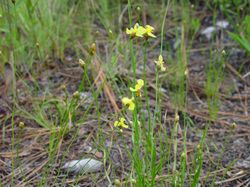
Xyris caroliniana
Carolina Yellow Eyed Grass
Wetland Indicator: FACW+
Physiographic Provinces: Piedmont, Coastal Plain
Native American usage:
Infusion of root taken for diarrhea and considered “good for children”
Photo credit: Lisa Kelly cas.vanderbilt.edu
Carolina Yellow Eyed Grass
Wetland Indicator: FACW+
Physiographic Provinces: Piedmont, Coastal Plain
Native American usage:
Infusion of root taken for diarrhea and considered “good for children”
Photo credit: Lisa Kelly cas.vanderbilt.edu
